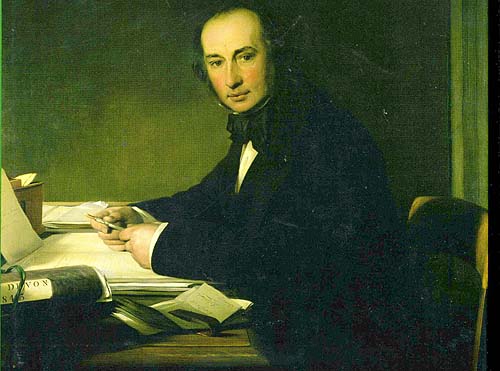
Bradford on Avon
Railway Station
Railway Station
2007
marked the 150th Anniversary of the Station at Bradford on Avon`s opening.
It was a year of celebration and there were a number of events to mark
it which are detailed here. A book was specially produced by the Bradford on Avon Preservation Trust covering the history of this remarkable Station and its buildings which were designed by the great victorian engineer - Isambard Kingdom Brunel. |
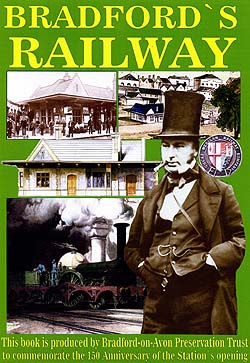 |
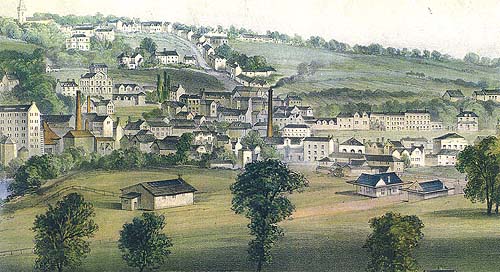 |
|
| The view of the town showing the completed buildings, but without the track as it was painted by Mrs E.Tackle in 1850. | |
1830 |
|
| The
successful opening of the Liverpool & Manchester railway led to widespread
interest in railways everywhere. On 4th January 1830 a public meeting at the Assembly Rooms in Bath, convened by a committee headed by Thomas Pycroft of Bath and John Harford of Bristol, heard William Brunton outline his ideas for a railway between the two cities. Brunton was a 52 years old Scots engineer whose chief claim to fame was the invention of a steam engine with a pair of mechanical feet which helped it to climb gradients. At a public demonstration it unfortunately exploded, killing 13 people. Brunton stressed that "by judicious selection of the line, and the arrangement made to the necessary embankments with arches of stone masonry, the road will be nearly level throughout…" - so no need for mechanical feet. Nothing further is heard of this proposal. |
|
1832 |
|
| The much more ambitious idea of a railway between Bristol and London was put forward by William Brunton and a fellow engineer, Henry Habberly Price, in a circular dated 7th May 1832. The route proposed was from Bristol via Bath, Bradford and Trowbridge to pass near Devizes and through the Pewsey Vale to Hungerford, Newbury, Reading, Datchet, Colnbrook and Southall to a site off Edgware Road in London. As far as Reading it would be following the line of the Kennet & Avon Canal. Financial support was not forthcoming so the scheme was dropped. | |
1833 |
|
| It
was lobbying from four Bristol businessmen, Thomas Guppy, John Harford,
William Harford and George Jones that preceded a meeting on 21st January
1833 between the Merchant Venturers, Bristol Corporation, the Bristol Dock
Company, The Chamber of Commerce and the Bristol & Gloucester Rail Road
Company to "take into consideration the formation of a Rail Road from
Bristol to London". They agreed to fund a survey of the route and deputed
Nicholas Rock of the Bristol Docks Committee to select an Engineer. Roch
had worked closely with Brunel on the improvements to the Bristol Docks,
but other engineers were also competing for the work: Brunton and Price,
who had promoted the 1832 scheme, and W.H. Townsend, responsible for the
Bristol and Gloucestershire Rail Road, a horse drawn tramway between Coalpit
Heath and Wharves on the River Avon. The committee selected the 27 year
old Brunel with Townsend as his assistant.John Harford of Blaise Castle
was a wealthy Banker and Merchant who had earlier backed Brunton`s scheme. A preliminary survey was demanded in a month. Brunel, travelling on horse back and lodging at country inns, surveyed the Brunton route through the Vale of Pewsey and the Kennet valley, and a more northerly route via Swindon and Wootton Basset. The latter gave the opportunity for branches to Oxford and Gloucester; it was this that Brunel recommended, with an estimated cost of £2,800,000. The project was formally launched at a meeting on 30th July 1833 at Bristol Guildhall, where it was decided to form a company with a board consisting of directors from Bristol and London. A prospectus was issued in August 1833, naming 12 directors from each city and coining the name "Great Western Railway". Shares were priced at £5 and money was quick to come in. To construct a railway and obtain powers for compulsory purchase of land it was necessary to obtain an Act of Parliament. |
|
Isambard
Kingdom Brunel painted by his brother in law - John Callcott Horsley in
1857 . |
|
1834 |
|
| The board of the Great Western Railway Company presented a bill for the construction of the railway. At the same time the London & Southampton Railway Company presented their bill, which included a branch from Basingstoke to Devizes, Trowbridge, Bradford and Bath, in direct competition with the G.W.R. Both proposals were subjected to long examinations in committee before being returned to the floor of the House of Commons. The London and Southampton bill was approved by both Houses of Parliament, but without the branch to Devizes, Bradford and Bath. The G.W.R. Bill was rejected by the House of Lords. The GWR then issued a new prospectus in September 1834, the map showed "probable branches" to Bradford and Trowbridge as well as to Gloucester and Oxford. The cost of the main line was estimated at £2,500,000. At the same time their rivals tried to raise support for a Basing, Bath, and Bristol Railway - a revival of the branch of the London & Southampton which had failed to win parliamentary approval | |
 |
|
| Basing and Bath (B & B) line was proposed in 1834, in competition to the GWR.If it had gone ahead Bradford would have no doubt had its railway by 1841 and not 1857. | |
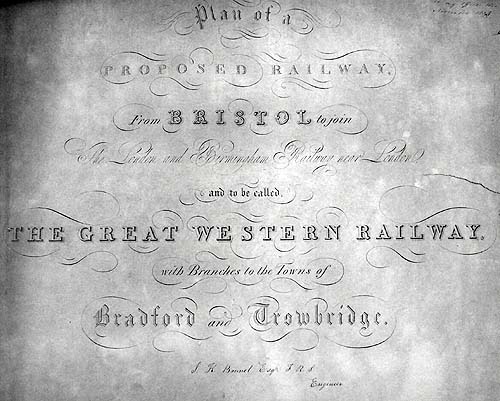 |
|
Frontispiece
to the early Plan for the Great Western including Bradford and Trowbridge
in 1834 |
|
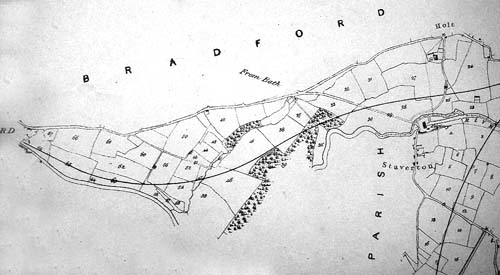 |
|
Map
showing original planned branch to Bradford on Avondated 1834, but never
proceeded with due to lack of funds. |
|
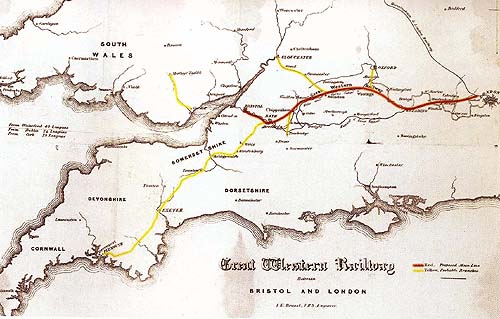 |
|
| A Map of the Great Western Railway from London to Bristol in 1834 | |
1835 |
|
| In February it was announced that capital of £2,000,000 had been raised. A new bill was now presented to Parliament. Another long examination in committee followed, but this time the bill was passed by both Houses of Parliament and received the Royal Assent on 31st August 1835. This included powers to make a branch from Thingley Farm, near Chippenham to a "field near the Gas Works in the part of the parish of Trowbridge called Islington, with another branch thereout from the south- western extremity of Kingston Farm adjoining the town of Bradford". | |
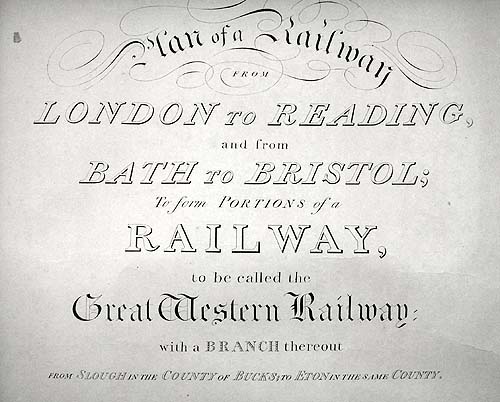 |
|
| Frontispiece to the original Plan for the Great Western Railway from London to Reading and then Bath to Bristol of 1834. | |
1836 |
|
| Construction started at the London and Bristol ends of the line. Brunel announced his intention of using a broad gauge of 7ft 0 ¼ ins. For the track, instead of the standard gauge of 4 ft 8 ½ ins in use on the London & Birmingham and other railways, to a meeting of the Directors on 15th September 1835. | |
1837 |
|
| It
had always been part of Brunel`s vision that his railway would be part of
a route from London to New York. A Great Western Steamship Company had been
formed in Bristol in 1836, with five of the same directors; Brunel offered
his services as designer. The vessel, "Great Western", was launched
on 19th July 1837; she made her maiden voyage on 8th April 1838 arriving
in New York fifteen days later. |
|
1838 |
|
| With
completion of the railway from London to Maidenhead, a regular passenger
service was started in June 1838. |
|
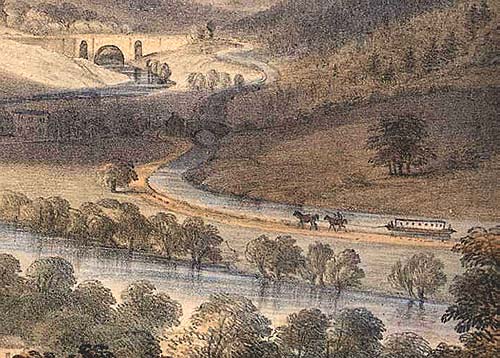 |
|
A
view showing a section of the Kennet and Avon Canal from Limpley Stoke
to Dundas Aqueduct, Claverton in 1850 |
|
1839 |
|
| The
London to Southampton Railway was opened on 10th June 1839 and by 11th May
the following year had reached Winchester. |
|
1840 |
|
| The
Bristol to Bath line was opened on 31st August 1840. 1841 |
|
| On
the 30th June 1841 the line from London to Bristol and on to Bridgwater
was opened to traffic. |
|
1843 |
|
| This year saw the completion of Swindon locomotive works and soon the first GWR designed engine, inevitably named "Great Western" | |
 |
|
| Pangbourne Station by Bourne. This Print gives an idea how Bradford would have originally looked as the building and shelter are very similar to Brunel`s designs for our station. | |
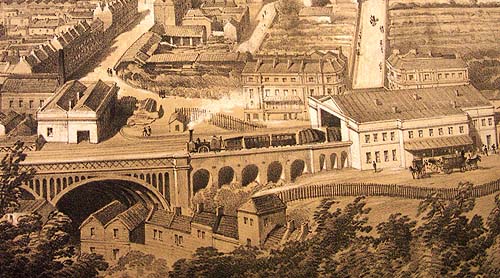 |
|
| A View of Bath by Everitt with a Firefly locomotive emerging from the covered station in 1846 | |
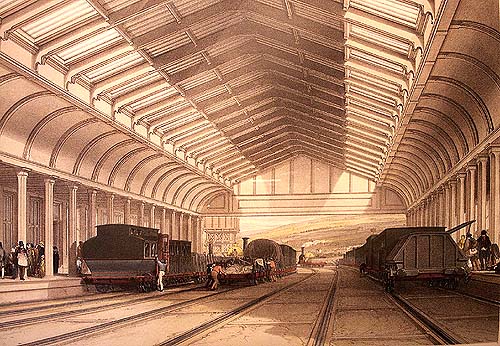 |
|
View
of Bath Station by Bourne in 1841. The roof covered all four tracks until
1897 |
|
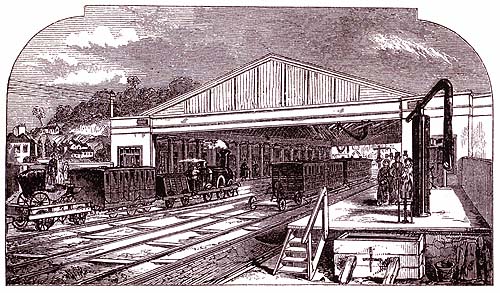 |
|
View
of Bath Station by George Measom in 1852 |
|
1844 |
|
| The
London and South Western Railway proposed a line from Basingstoke to Swindon,
in the heart of GWR territory. The GWR countered by promoting two nominally
independent companies to extend the broad gauge lines: the Berks & Hants
railway and the Wilts & Somerset Railway. The latter would run from
Thingley, just west of Chippenham, to Salisbury, with branches to Devizes,
Bradford and Frome, and a "coal branch" to the mines at Radstock.
At Salisbury the Wilts & Somerset was to connect with the London &
South Western's branch from Bishopstoke. The first meeting of the Wilts & Somerset was held at the "Bath Arms", Horningsham, near Longleat with Walter Long M.P. in the chair, on 9th July 1844. Plans for the line had been submitted by Isambard Kingdom Brunel. Charles Alexander Saunders, Secretary of the G.W.R., attended the meeting and advised on raising the capital (estimated by Brunel at £650,000) for which the G.W.R. would be guarantor and offer a return of 3 ½% (later 4%) on each share , being itself prepared to subscribe up to half the capital. The G.W.R. was to have a perpetual lease and the right to work the line. A month later it was agreed to extend the line from Frome to Yeovil, and from Westbury to Weymouth, at an estimated cost of £350,000. At a further meeting the name of the company was changed to the Wilts, Somerset & Weymouth Railway. A bill was put forward and submitted to the recently established Railway Department of the Board of Trade, which had taken on the task of regulating the flood of new railway proposals. The Board of Trade stipulated that a better line of communication must be provided between the new railway and Bath and Bristol than by the junction at Thingley (though the extra mileage over this route would have boosted the profits on goods on the line). |
|
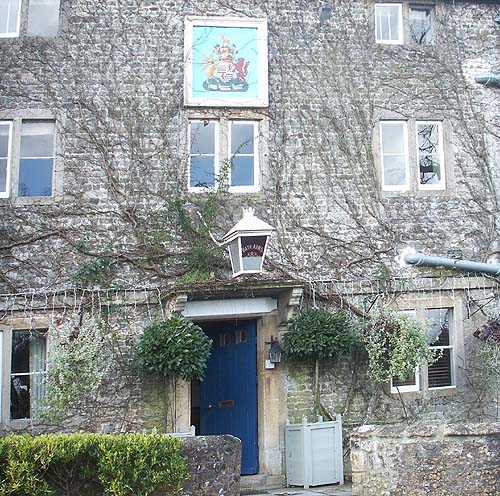 |
|
| The Bath Arms at Horningsham, near Longlet, Warminster where onthe 9th July 1844 first meeting of Wilts & Somerset Railway was held with major land owner-Walter Long as Chairman and I.K. Brunel as Company Engineer. This decision was eventually to lead to the railway coming to Bradford on Avon. | |
1845 |
|
| The Wilts, Somerset & Weymouth railway act received the Royal Assent on 30th June 1845. A condition was imposed that in the next session of Parliament the company was to apply for an extension from Bradford to Bathampton (on the GWR main line to Bath). Brunel warned of the expense of constructing this, estimated at £150,000. By October 1845 the line from Thingley had been staked out to Salisbury and almost to Bruton. | |
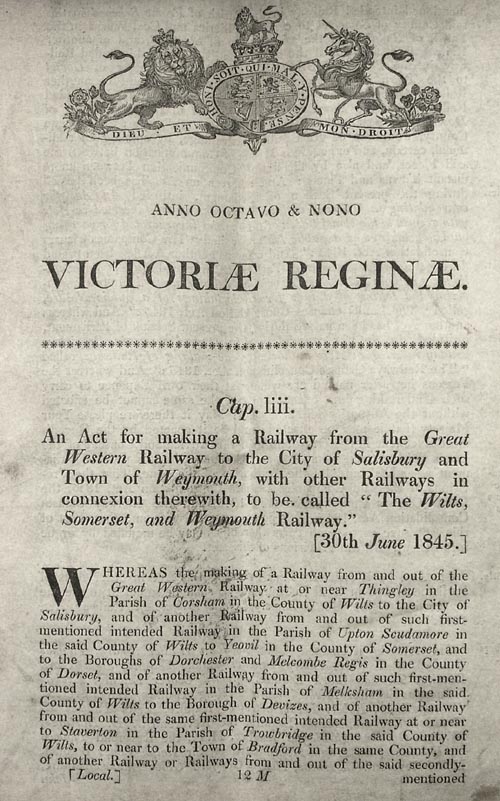 |
|
The
Act of 30th June 1845 detailing Bradford |
|
 |
|
| A map drawn by George Ashmead in 1837 but later adapted to show the station buildings and cuttings c.1850 before the track was to be laid for the opening in 1857. The Spoil from the Tunnel is shown on French Grass. | |
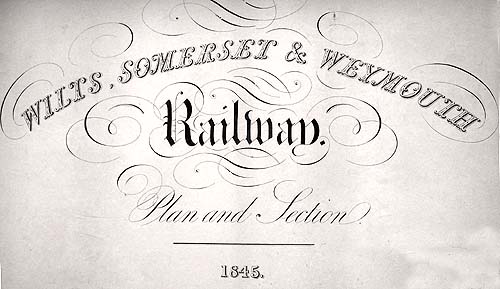 |
|
 |
|
| An interesting map of 1845 showing the propsed route of the railway line from Bradford to Bathampton with inset maps of stations. | |
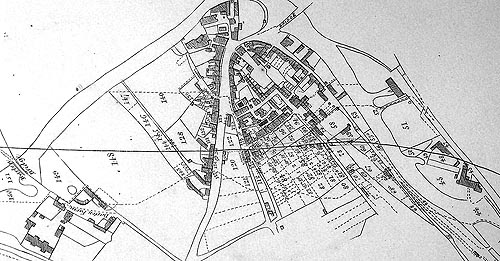 |
|
| A close up of 1845 map showing Bradford section with proposed route for railway. The numbers are from the detailed reference book which shows the former owners and tenants before being purchased by the Wilts.Somerset & Weymouth Railway Company | |
1846 |
|
| On
3rd August 1846 an additional Act received Royal Assent authorising the
construction of a branch from Bradford to Bathampton, and an extension from
Weymouth to the Quay, besides other minor changes. Contracts were to be
let from Thingley to Staverton, Staverton to Heytesbury and Heytesbury to
Salisbury. The directors required that the contractors were to co-operate
in preventing Sunday working where it was not an actual and indispensable
necessity. The rush of new railway projects made it difficult to find firms to take on the work, but in February 1846 the contractor had erected workshops at Melksham and was "to break ground immediately". By August the Melksham and Trowbridge contracts were in full operation. Brunel reported to the Directors that in October a start would be made on laying the permanent way from Thingley to Bradford. The "railway mania" of the 1840s led to greater demands for capital than the market could raise. It rose from about £4 ½ million for 1842 to £60 million in 1845 and £132 million in 1846, triggering the financial crisis that broke the WS&WR. |
|
1847 |
|
| On
29 January 1847 Messrs. Tredwell, the contractors, started work on the Bathampton
branch. Later that year there was an incident when some navvies brawled
at Bathampton. John Bailey, a constable not in uniform, announced his status and ordered them to stop rioting. They replied by hitting him so hard that he later died of his injuries. Maurice Perry was the only navvy to be recognised and arrested and was later sentenced to death. The major engineering works on the line from Thingley to Westbury were undertaken. There was a complaint that work had proceeded on Sunday 21st march 1847 despite the rule against Sunday working. This had been at Ladydown, where water had to be run into a temporary channel to keep the Kennet & Avon canal open while the railway was tunnelled underneath it. More difficulties were found at Avoncliff where the banks of the canal were found to be insecure. A temporary aqueduct was built of timber prior to the railway tunnels and the restoration of the canal, but traffic on the canal was interrupted and a fine had to be paid. |
|
1848 |
|
| Work
continued, but at a slower pace. Nevertheless the bridges over the River
Avon near Bradford Great Wood and below Greenland Weir were built as was
the tunnel under St. Margaret's Hill and the bridges carrying the Frome
and Trowbridge roads over the railway. So, too, were the station buildings
and goods shed. On the main line the rails were laid to Westbury and that section opened in September 1848. On Saturday 2nd September a special train driven by Mr Gooch, the locomotive department superintendent, assisted by Mr Brunel, drove a train of directors and special guests from Chippenham through Melksham and Trowbridge to Westbury. Crowds greeted the train: at Melksham the band played; at Trowbridge a cannon was fired, at Westbury the Mayor presented an address. |
|
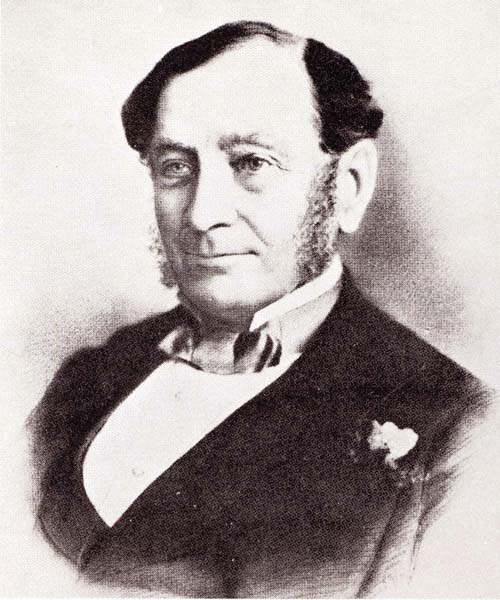 |
|
| Sir Daniel Gooch was appointed by Isambard Kingdom Brunel as locomotive superintendent of the Great Western Railway at the age of twenty-one. He designed the finest locomotives of the period and in 1865 became Chairman of the G.W.R. and rescued it from bankruptcy. | |
 |
|
The
Goods Shed at Bradford on Avon in 1850 awaiting tracks |
|
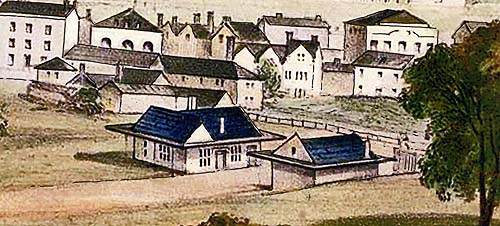 |
|
Bradford
on Avon Station in 1850,seven years before the opening showing all the
buildings completed. |
|
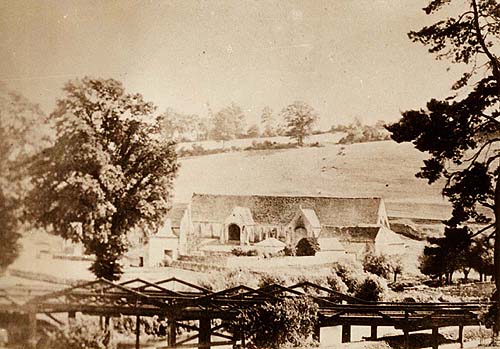 |
|
| In the foreground of this old photograph looking down on to Barton Farm is the original wooden bridge which carried the railway over the Avon wets of the station.A box girder bridge replaced the wooden bridge in 1872 and itself was replaced in 1960 with the present bridge. | |
1849 |
|
| At
the half- yearly meeting of the WSWR on 26th February 1849 the shareholders
were told that because of the financial depression the only work in progress
was that already under contract. Rails were being laid on the Bradford Branch,
and work would concentrate on the Westbury- Frome line. On 4th June 1849 the G.W.R. Secretary wrote to the WSWR Directors saying it was the "strong and decided opinion" of his directors that all works should be stopped except those from Westbury to Frome. In October 1849 the WSWR directors resolved "that it is highly desirable that the railway should be sold to the Great Western Railway Company upon such terms as will produce to the shareholders in this company, the same rate of interest .. as is provided for them under the agreements between the two companies that was signed on 31st December 1849"; this gave the paid up shareholders a return of 4% on their investment. |
|
1850 |
|
| On
14th march 1850 the WSWR was transferred to the GWR, though the Act of Parliament
abolishing the WSWR was not passed until 3rd July 1851. On 7th October 1850 the line from Westbury to Frome was opened. But on taking over the WSWR the GWR had announced its intention of abandoning the Bradford branch. There was widespread dissatisfaction, as also among people in Devizes, work on whose branch was now suspended. |
|
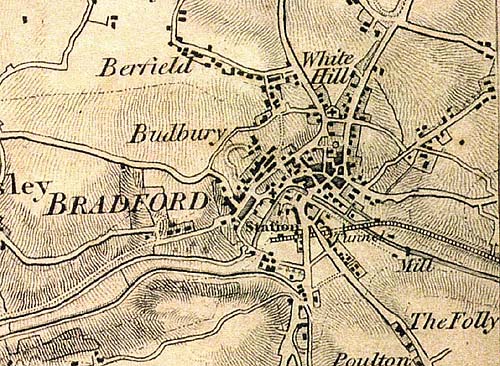 |
|
A
map of Bradford on Avon c.1850 showing the incomplete railway line |
|
1852 |
|
| On
30th June 1852 the Great Western Railway Act No. 1 gave a legal confirmation
of the sale of the Kennet & Avon Canal to the GWR, which had effectively
destroyed its trade. A coalition of local interest brought an action against the GWR to compel them to complete the lines for which the Wilts Somerset & Weymouth Railway had possessed powers. It was heard at Somerset Assizes in the Michaelmas Term of 1852; the lawsuit was defeated, except for the Bradford to Bathampton branch. |
|
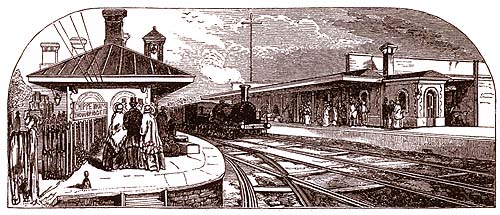 |
|
Chippenham
Station in 1852 |
|
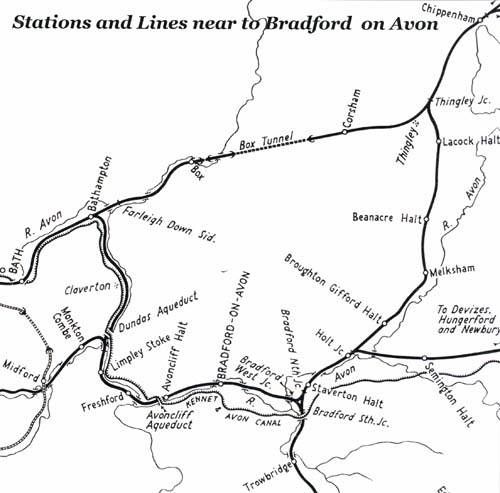 |
|
1853 |
|
| The GWR appealed against the judgment that it should complete the Bathampton branch, but this was rejected on 23rd April 1853. A mandamus had been issued commanding the GWR to complete the branch, to which the company protested that its powers to acquire land had expired. This Bail Court refused to accept this; it was contended that the GWR could acquire the land by agreement with the landowners. A peremptory mandamus was awarded by the court. | |
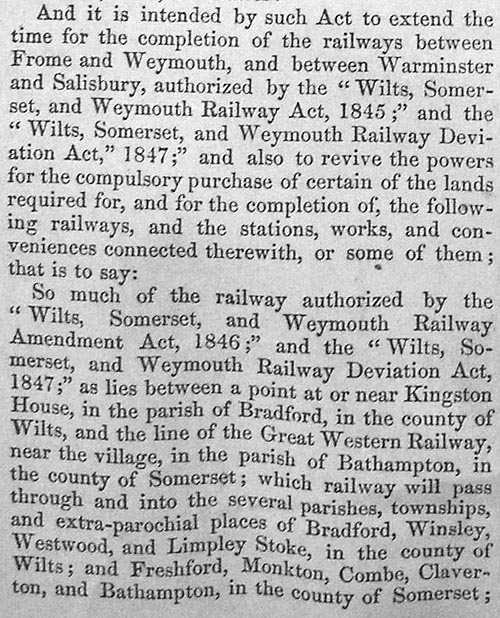 |
|
An
abstract from the Act of 1854 dealing with the extension from Bradford
to Bathampton |
|
1854 |
|
| A
new Act of Parliament received the Royal Assent on 31st July 1854 granted
an extension of time for the completion of the Wilts, Somerset & Weymouth
Railway, but stipulating that if it was not complete within the three years
it would be unlawful for the GWR to pay a dividend on ordinary capital until
the line was completed and opened. Powers were granted to raise an additional £1,000,000 in capital. Negotiations were re-opened with land owners along the route, a timber bridge built over the Avon at Barton Farm and other engineering work re-started. |
|
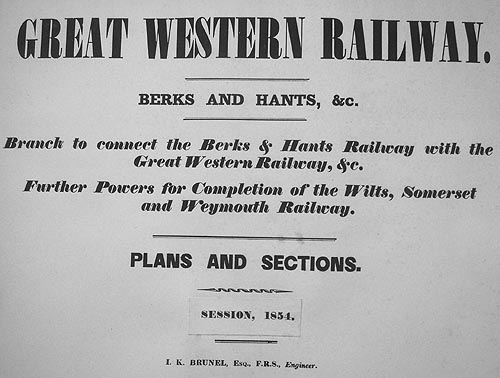 |
|
1855 |
|
| Work continued, it was only in this year that John William Yerbury sold land at Belcombe Court for the building of the railway. The agreement included the provision of a decorative underpass for access to the river and the planting of trees beside the line to screen it from the house. | |
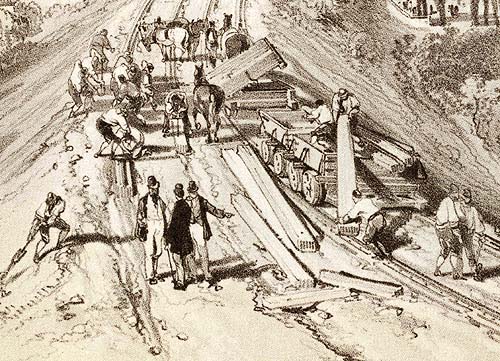 |
|
This
print by Bourne shows track laying along the Great Western railway line
near Bath. |
|
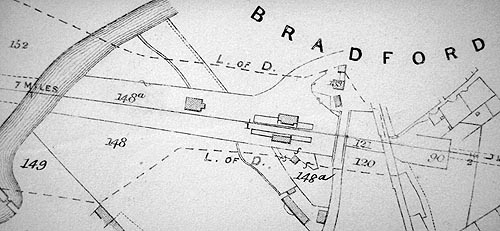 |
|
The
proposed Plan of the Railway layout updated by the Great Western Railway
in 1854 |
|
1856 |
|
| In
January 1856 the G.W.R. applied for an extension of time. On 17th January
Colonel Wynne made an inspection on behalf of the Board of Trade and believed
another three to four months was required for completion. The main obstacle
was the tunnel under the Kennet & Avon Canal at Dundas. It was reported
that it had to be cut through material of a treacherous nature and the side
walls were built in lengths not exceeding 10 ft., each section in a pit
whose sides had to be closely shored all round. The requirement was that
the canal must be kept open for traffic and so could not be drained. On 21st July 1856 the "Wiltshire Times" reported the fall of a wall near the line of the railway, killing one workman and so injuring another that he was not expected to live. |
|
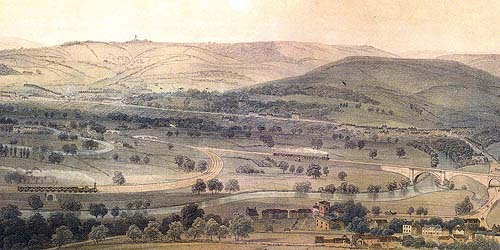 |
|
| This engraving shows the spur at Bathampton for the line that went on to Bradford and was painted by Bradford artist- Mrs Elizabeth Tackle c.1850. | |
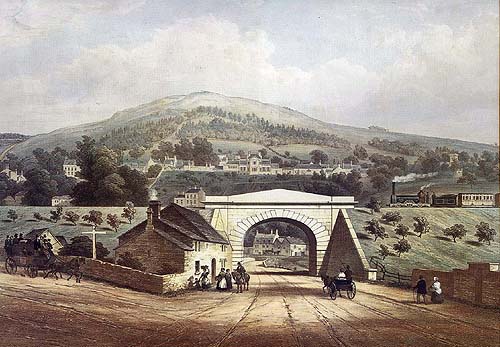 |
|
| This view again by Mrs Elizabeth Tackle shows the Viaduct at Bathford c.1850, with the Crown Inn in the distance. She reveals the end of an era with the Firefly locomtive speedily travelling above the older mode of transport the stage coach. The vantage point is now the roundabout and the cottages at the bottom have long since been demolished.The bridge was built by Isambard Kingdom Brunel with the Great Western Railway, and completed in 1841. | |
1857 |
|
| On
16th January 1857 Colonel Yolland inspected the completed line between Bradford
and Bathampton. He found that the permanent way had only just been laid
and was very rough. The station buildings and signalling were incomplete
and he said it was not fit for opening to passenger traffic. After re-inspection
a fortnight later, he granted a certificate. On 2nd February 1857 the line
finally opened. The "Wiltshire Times" reported (on 7th Feb. 1857): On Monday last the line between Trowbridge and Bath via Bradford was opened for traffic The first train arrived here soon after 7.00 am and 10 trains are registered to run, viz 5 up and 5 down. Considerable excitement prevailed throughout the day, on the arrival of each train the railway station was besieged by hundreds of eager spectators. The celebrated Bradford brass band played lively airs at intervals during the day, and as often as might be heard the sound of the merry church bells. A good dinner was provided in the evening by Mr J,C. Neale of the Swan Hotel. We learn that the inhabitants of the town are not contented with the list of fares laid down by railway company; for a return ticket from Bradford to Bath a distance of 9 miles, a fare of 3/3d is demanded, whereas from Trowbridge to Frome, a similar distance, the price is only 1/6d. The line curves away from the main about on mile from Trowbridge station through Bradford, Avoncliff, Freshford, Limpley Stoke to the junction at Bathampton where it joins the GWR to Bath etc., passing 3 times under the Kennet and Avon Canal and 6 bridges by extensive viaducts over the river Avon. |
|
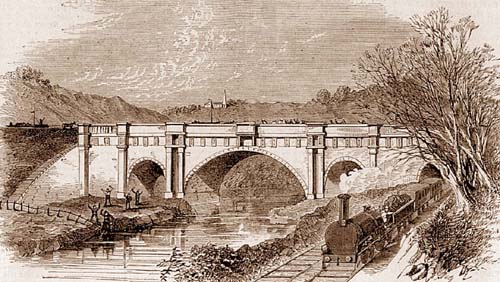 |
|
| An engraving produced for the Illustrated Home a few days after the opening of this branch of the railway on February 2nd 1857. In the background is the Dundas Aqueduct at Claverton with enthusiatic spectators watching the Firefly speeding past on its way to Bath. | |
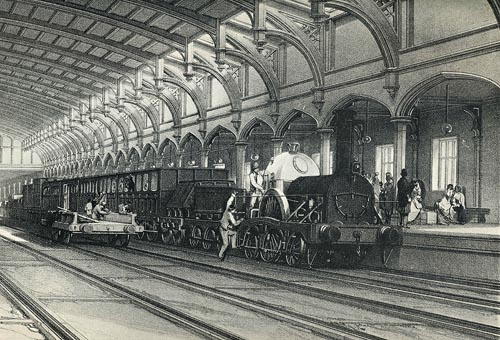 |
|
A
Firefly similar to that seen at Bradford on Avon in 1857 here depicted
by Bourne at Temple Meads Station in Bristol. |
|
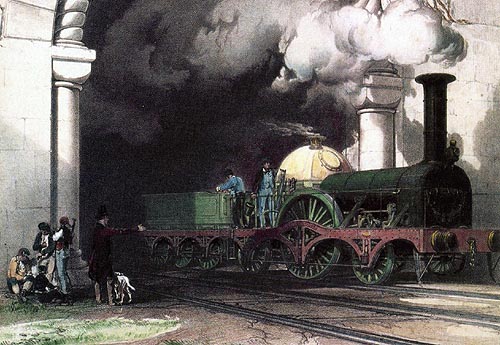 |
|
A
Firefly |
|
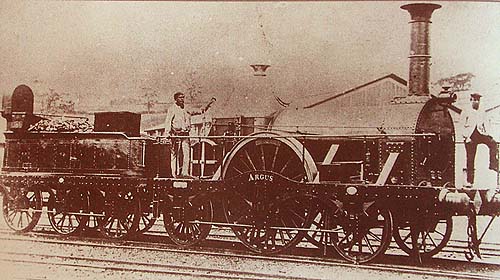 |
|
A
Firefly Locomotive,designed by Daniel Gooch were amongst the first locomotives
to be seen on the Bradford line. |
|
| Again
on June 27 1857 The Wiltshire Times reports: Bradford. On Monday 22nd this unusually quiet town was greatly enlivened by an excursion train which stopped at the Bradford station on its way to Weymouth. Here it was joined by the brass band belonging to the town, to whom great credit is due to for the very praiseworthy way in which they enlivened the pleasure of the day. The weather was remarkably favourable but a goodly number of passengers (150-200) found difficulty in obtaining seats and it would have been easier if rail carriages had been awaiting the train, and it would have been given greater satisfaction. Another Wiltshire Times news item reports that: On July 25 1857 Excursion Train Yesterday morning a monster train from Bristol, Bath and Bradford passed our station on its way to Salisbury. It consisted of about 30 carriages, propelled with two powerful engines. The train was a very heavy one and must have conveyed about 2,000 persons. Our neighbours at Bradford a short time ago expressed themselves to be annoyed with the accommodation they received on an excursion to Weymouth, on this occasion they have been preferred. However, many persons from Trowbridge we believe availed them selves of the privilege by obtaining tickets at Bradford. |
|
| The
initial service of five trains per day each way was not generous, but no
doubt adequate for the available traffic. In any case, the long stretches
of single track, coupled to the heavy gradients on the southern section,
made anything more ambitious impossible. After waiting seven years the people
of Bradford were offered a free excursion train to Weymouth. In the same
year the 8-mile branch from Holt Junction to Devizes was opened on 1st July. The whole route from Bradford junctions to Bathampton was constructed for a double track but from Barton Farm in Bradford to Bathampton only a single track was laid. It seems irrational after all the effort to drive double tunnels under the Kennet & Avon Canal. From Bradford Junctions, where the branch leaves the Chippenham to Trowbridge line to Bradford, the double track consisted of Brunel`s original design of rails laid on continued baulks of timber, with transverse wood transoms at intervals. From Bradford to Bathampton the rails were laid on cross sleepers, similar to today's track except that the sleepers were spaced at 3 ft intervals. |
|
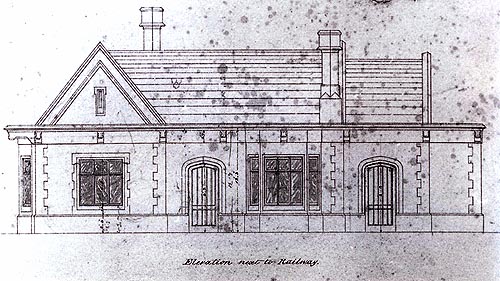 |
|
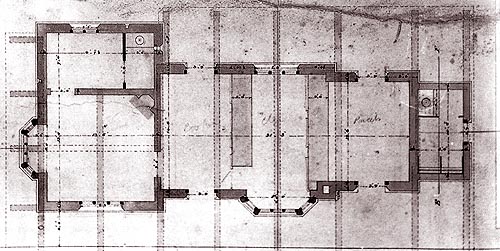 |
|
| The contract drawings for Twyford station built in 1846, which was the largest type of standard wayside station.The same design was used at Bradford on Avon | |
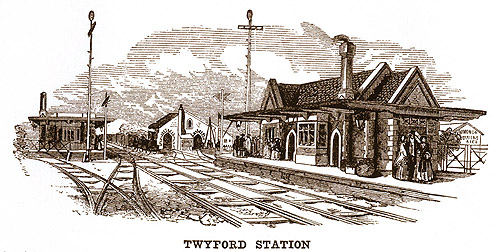 |
|
A
view of Twyford Station in 1852 which is almost identical to that of Bradford
on Avon with its Goods Shed in the background and Passenger Shelter on
the left.Sadly all these buildings disappeaerd with the quadrupling of
the track to Standard Gauge in 1892. |
|
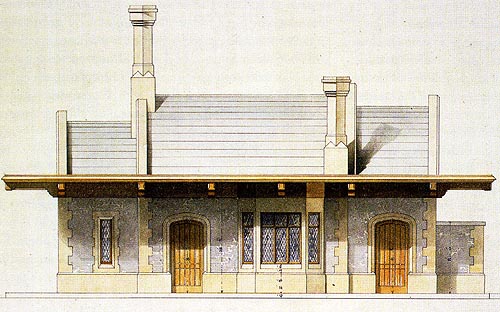 |
|
The
following 3 drawings are the 1843 contract drawings for Culham station
designed by Brunel. They are almost the same as those for Bradford apart
from a Gable that was added to this station. |
|
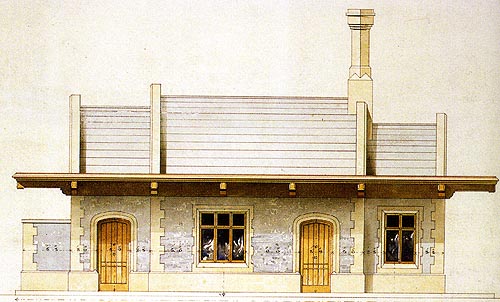 |
|
Culham Station (ii) |
|
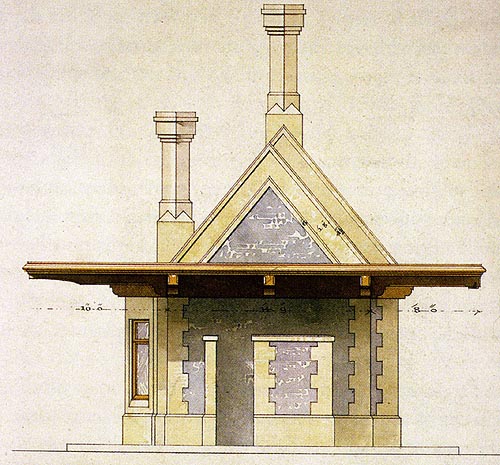 |
|
Culham Station (iii) |
|
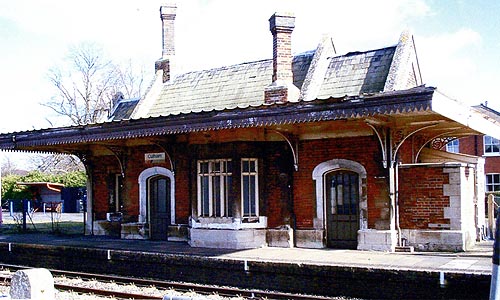 |
|
| Culham Station was formerly known as Dorchester Road and is on the Didcot- Oxford branch and is the only survivor that resembles Bradford on Avon Station today. | |
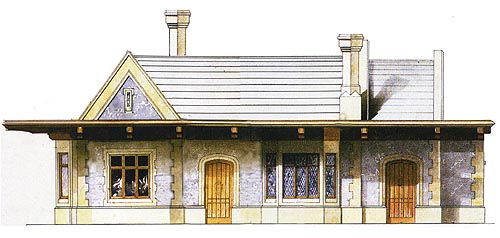 |
|
| A composite view of the Station at Bradford on Avon using Brunel`s drawings for a Wayside Station in 1843. | |
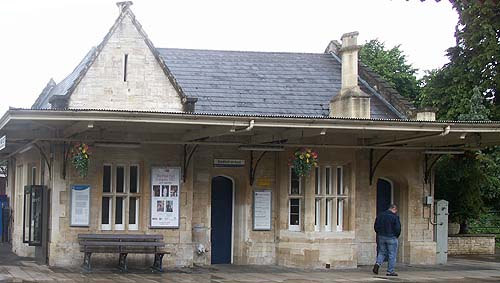 |
|
The
same view of the Station at Bradford on Avon today |
|
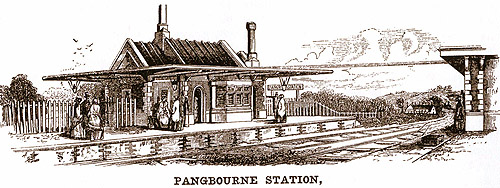 |
|
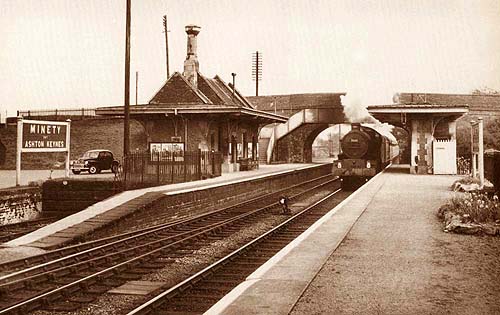 |
|
Minety
Station |
|
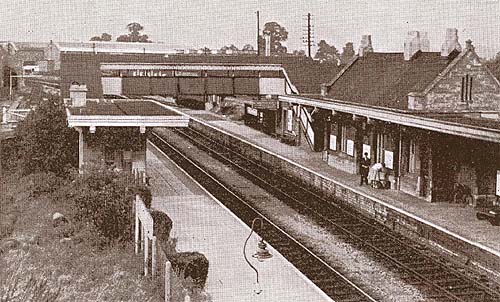 |
|
Melksham
Station |
|
| Besides his work on cuttings, embankments, tunnels, bridges, track, signalling, locomotives and all details of railway design, Brunel also produced standard designs for stations. For Bradford the design for Twyford Station (on the G.WR. main line between Maidenhead and Reading) was re-used, but built entirely of local Bath stone, rather than in brick and stone. It is characterised by a steep gabled roof, flat canopies or awnings on cantilever beams and brackets, doorways with flat Tudor arches, and the tall, diagonal chimneys which were a trade mark of Brunel`s stations. | |
| This
design was the most elaborate of Brunel`s five standard designs for "roadside"
stations. At Culham, Oxfordshire, there is a simpler but very similar type,
the only survivor of many more, most of those on the main line have been
destroyed when the track was quadrupled in the 1870`s. The style is similar to the Elizabethan/Jacobean style used by architects like Edward Blore and Anthony Salvin for many of their country houses of this period. Apart from the canopies, the stations could easily serve as lodges or estate houses to one of these grand country estates. From Brunel`s sketches, the detailed plans were drawn up by his assistants. The names of J. Geddes, I. Nolloth and F. Prinsit have been recorded as assistants in 1848, but it is not known which worked on Bradford. Geddes and Nolloth were responsible for the station at Melksham, with a somewhat similar design to Bradford |
|
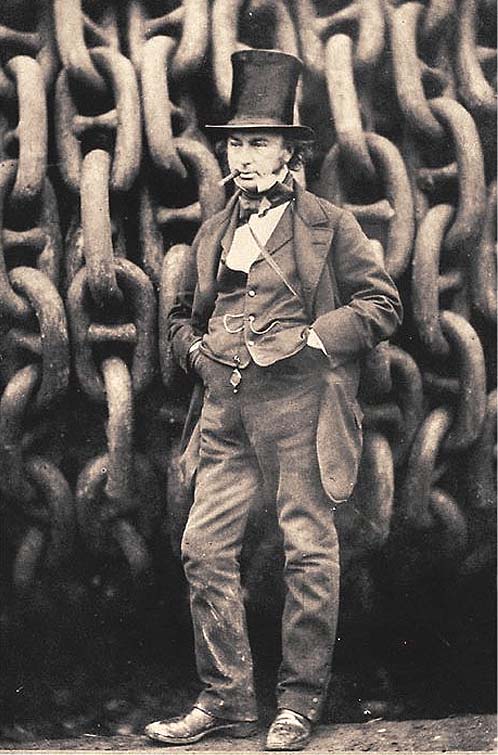 |
|
1859 |
|
| The death of Brunel in 1859 shocked the Great Western severely. His creative genius saw most of his work completely fulfilled except for the problems with the ship 'Great Eastern' and the Clifton Suspension bridge which would be finished in 1864 after 30 years construction. It was on the 'Great Eastern' that Brunel suffered a heart attack and died on the 15th of September. He was buried at Kensal Green cemetery in London, not far from his own Paddington station | |
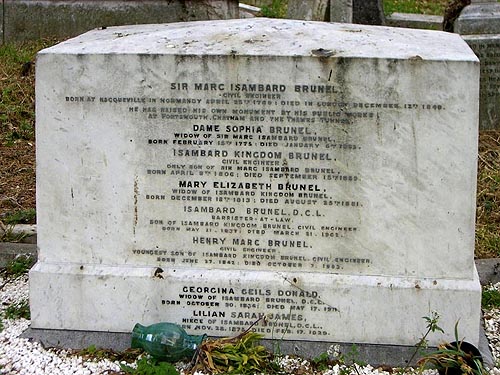 |
|
The
Brunel Family Tomb at Kensal Green Cemetery in London |
|
1861 |
|
| The
Weymouth, Portland & Dorchester Telegram of 1 August 1861 reports that: "The facilities afforded by this company (GWR) for trips to this favourite watering place have induced thousands to avail themselves of the facilities offered. On Monday last an excursion train of 22 carriages containing 850 passengers arrived from Bath and Bristol." Later on the 29 August it wrote: "For the last few weeks, the excursion trains have brought into the town several thousands of visitors and although their stay in many cases is of very short duration, the lodging houses are pretty nearly always full." Many of these travellers would pass through Bradford on their way to Weymouth. The railway gave cheap, speedy travel and Weymouth boomed with this new trade. |
|
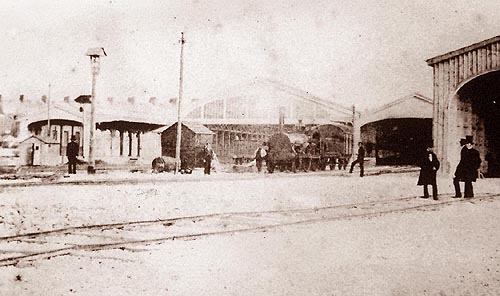 |
|
An
early photograph of Weymouth Station in 1857, the year of its opening. |
|
1870 |
|
| The G.W.R. made an agreement with the coal mine proprietors of the Somerset coalfield that the Bristol & North Somerset Railway (which was helped by G.W.R. and opened in 1873) was to provide a standard gauge line between Radstock and Salisbury. | |
1871 |
|
| Charles Keslingbury shown as Station Master in the Census for that year living in the Station Master's House at the corner of St. Margaret's Street and the Station Approach. | |
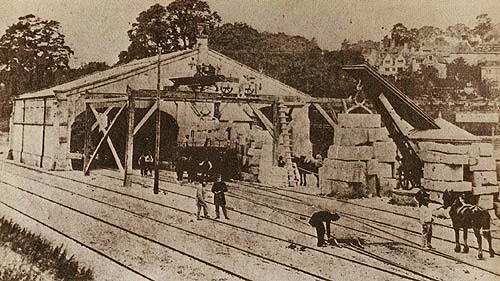 |
|
| The Goods Shed, now the site of the main Station Car Park in its hey day c.1870 with the Broad Gauge tracks. | |
1872 |
|
| The GWR obtained an Act of Parliament for the construction of the Severn Tunnel, which would provide a direct link between the South Wales coalfields and the South of England. | |
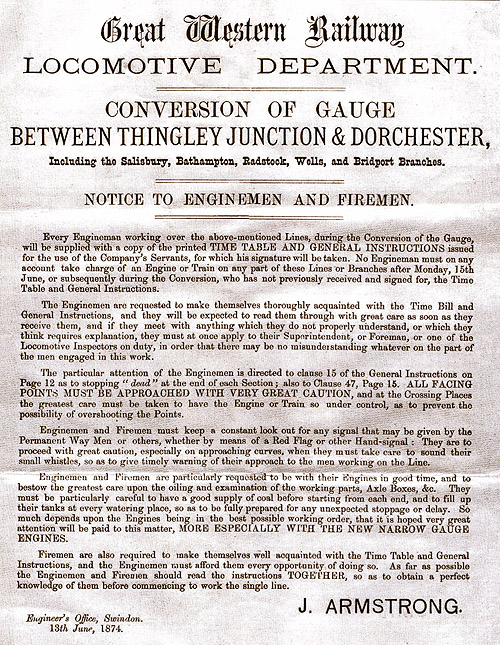 |
|
Notice
concerning the Conversion from Broad Guage to Standard in 1874 |
|
1874 |
|
| In February 1874 the GWR`s directors announced that in view of the obligation imposed by the agreement with the Somerset coal owners, that they were "of opinion that the convenience of the public will be best met, and the interest of the Proprietors best secured, by the alteration from Broad to Narrow Gauge of all the lines in the district." The work was estimated to cost £290,000 plus £70,000 for rolling stock (this would not have included all coal wagons and other goods wagons, many of which were normally owned by the firms whose freight they carried). In just 5 days, from 18th to 22nd June 1874, the entire length of the Bradford junction to Bathampton line was converted to standard gauge, as well as the line from Thingley Junction to Frome. | |
 |
|
Conversion from Broad Gauge to Standard in 1874 |
|
| The Up line of the former and the Down line of the latter were converted first, a reduced service being maintained on the other line. From Bradford to Bathampton the single track was laid with cross-sleepers; additional chairs had already been fixed to these, so the outside rail could easily be transformed into the new chairs. The rest of the track was all laid on longitudinal timber baulks. The transoms connecting these were marked ready for cutting; it remained to saw them through and then shift the timber with its rail over to its new position, fix it, and re-ballast the track. 1,800 men were employed, many brought in from outside, mostly from the Oxford division on a special train on 16th June. The workmen wore numbers and operated in parties of | |
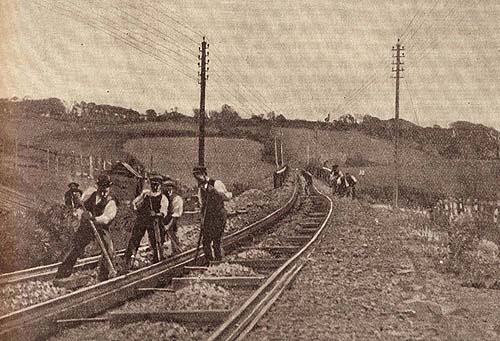 |
|
| 20
under a ganger who took charge of 1 to 1 ½ miles of track. Work continued from dawn to dark, about 18 hours each day. The GWR provided sheds for the men and straw to sleep on; smoking and drinking spirits were forbidden. The workmen were paid off on 26th June, two special trains conveying them back. On 21st June nine long trains of standard gauge carriages were brought in from Swindon. Normal services were resumed with the end of the Broad Gauge era. |
|
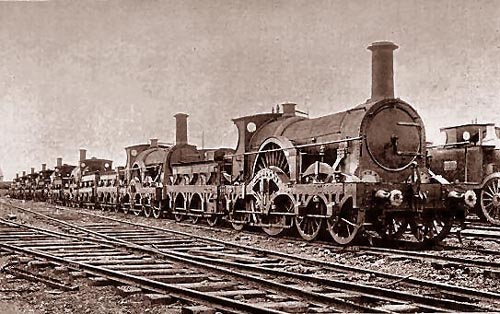 |
|
 |
|
Redundant
Broad Gauge Locomotives at Swindon |
|
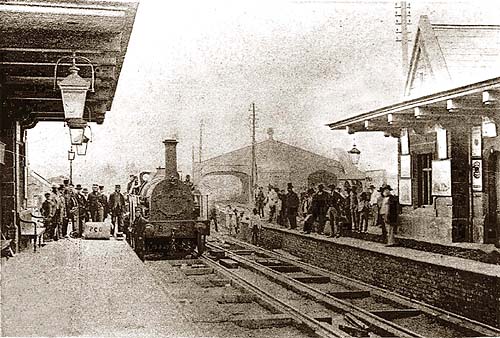 |
|
| The historic event when between 18th and 22nd June 1874 the Broad gauge line was converted to Standard gauge. on the left is a broad gauge train on its line whilst parallel is the new standard gauge. The photograph now held in the Trowbridge Museum could so easily have been Bradford as comparisons with images of the station and the Goods Shed at this time are almost identical. It is in fact Trowbridge before majopr alterations and shows what a gem we have lost when caompared with the station today. | |
1875 |
|
| On June 11th, 1875 the 10.18 am from Bath to Salisbury was derailed at Bathampton, where it failed to take the points on to the Bradford branch. The engine and leading coach overturned. One of the passengers jumped out and was killed; others were injured. The main line at this junction had three rails to accommodate broad gauge or standard gauge trains, but the points were only for standard gauge. | |
1877 |
|
| The
Signal Boxes were installed at both Bradford on Avon with 30 levers and
Bradford Crossing (later known as Greenland mill Crossing). |
|
1878 |
|
| The Timber bridge over the River Avon near Greenland weir was rebuilt in steel. | |
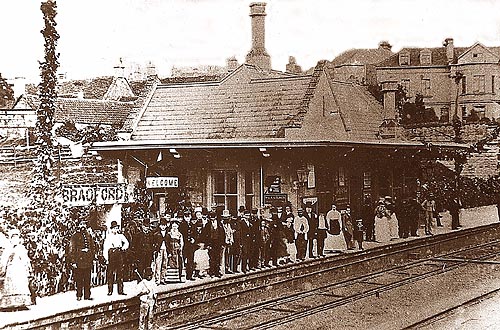 |
|
| The great event of the year 1879 was the holding in Bradford of the 20th annual show of the Keevil and District Society- The show was held in a different town or village each year. | |
1885 |
|
| The Bradford to Bathampton line was doubled in anticipation of increased goods traffic through the Severn Tunnel. | |
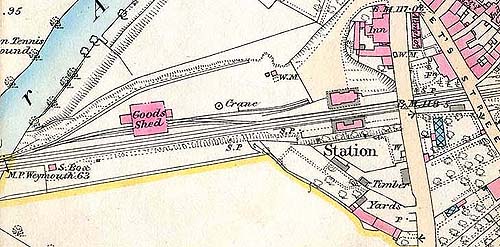 |
|
Ordnance
Survey map of 1886 showing the layout of tracks and buildings at Bradford. |
|
1886 |
|
| On 1st September 1886 the Severn Tunnel finally opened to goods traffic, and in November to passenger traffic. The tunnel's construction had been a 13 year saga of struggle against inrushes of water which had flooded the works and was eventually coped with only by continuous pumping. | |
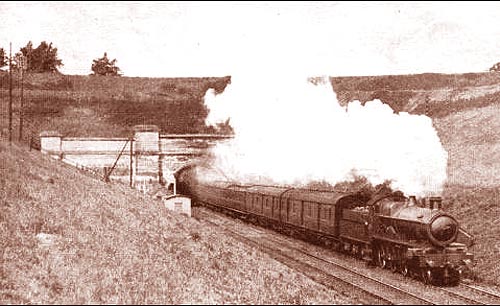 |
|
| The Severn Tunnel, which links England with Wales was completed in 1886 at a cost of nearly £2, 000, 000. | |
1887 |
|
| The
passenger timetable shows seven trains a day in each direction between Bath
and Weymouth, with three more between Bath and Trowbridge. |
|
1888 |
|
| Trowbridge was selected as the County Town of Wiltshire, partly because its railway connections were claimed to make it more assessable than other towns. | |
 |
|
Advert
for F. B. Noris of Bradford on Avon. c.1890. |
|
1895 |
|
| The name board on the station was changed from "Bradford" to Bradford on Avon". It was Canon Jones (1817-85) who persuaded the authorities to re-name the town from Bradford to the name it bore in AD652, Bradford on Avon. This no doubt helped differentiate it from the northern town of the same name. A west curve was laid at Bradford Junction to enable expresses from Paddington to Bristol via Swindon to divert Bradford without reversing when there were engineering works on the main line. | |
. |
|
| The Railway Station, 1897. The station staff and travellers are frozen in a moment in time as they pose for the photographer at the local station. This must have been during Queen Victoria's Diamond Jubilee | |
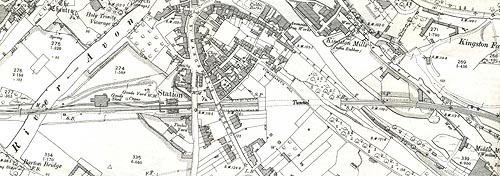 |
|
The
1901 O/S map showing the tunnel and bridges over roads and the river that
were needed. |
|
 |
|
 |
|
| These two photographs show the E Company (Bradford on Avon) of the Wiltshire Rifle Volunteers on their way to camp in 1903, wearing the new khaki uniform and slouch hats adopted during the recent South African War and the new "Moonrakcr" badges. | |
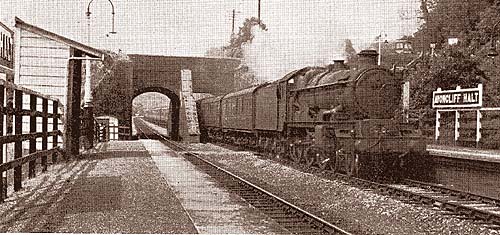 |
|
Avoncliff
Halt near Bradford on Avon |
|
1906 |
|
| Opening of the Halt at Avoncliff near Bradford on Avon. | |
 |
|
| Railway Station Staff, c. 1910. This undated photograph shows the compliment of staff at the local railway station. This postcard view was probably taken inside the goods shed where the full staff is pictured, from the station master to the porter. With the ending of goods traffic at the station in 1965, the shed was removed and the site has now become a part of the car park. | |
1914 |
|
| When the Great War broke out, the Government, by an Order in Council, assumed supreme control of all the railways in the United Kingdom immediately after the declaration. When the war was finished, the railways, the lines, the rolling-stock and plant which had been requisitioned by the Government were handed back to their owners, and a measure of compensation presented for the loss they had inevitably sustained. | |
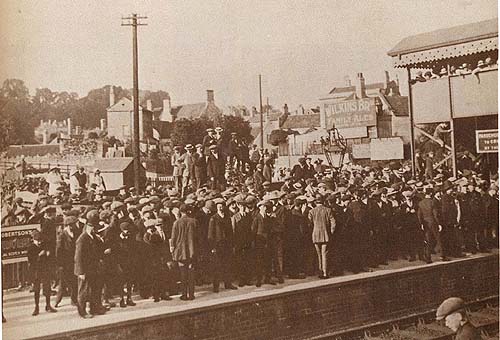 |
|
At
first service in the armed forces in the First World War 1914-1918 was
voluntary and any firms encouraged their employees to "join up".
In this picture we see workers from Spencer Moulton's giving volunteers
from the firm a big send-off from Bradford railway station. |
|
1920 |
|
| The 1920`s saw the introduction of the G.W.R.`s Castle Class locomotives which were a group of 4-6-0 steam locomotives designed by the railway's chief engineer Charles Collett for working the company's express passenger trains | |
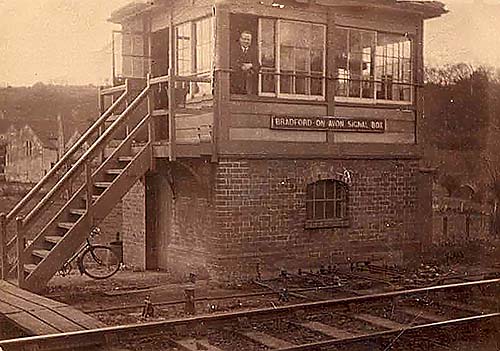 |
|
Bradford-on-Avon
Signal Box, c. 1920. This is a photograph of the signal box that controlled
the goods yard at Bradford-on-Avon. |
|
1923 |
|
| A Railways Act was passed which grouped all the numerous lines and small independent companies into four big groups All the famous old titles such as the "Great Northern" and "Caledonian" vanished-all, that is, except the Great Western which alone preserved its identity through the grouping, which took effect on 1 January 1923. The effect of the grouping of the Great Western's mileage was to increase it by 560 geographical miles, and by 3, 365 miles of single track. | |
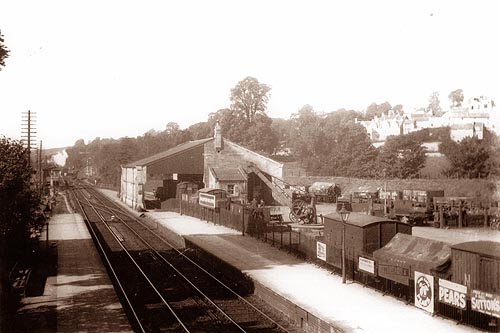 |
|
This
photograph of the Goods Shed and yard taken from the Passenger bridge
in 1926 by H.C.Casserley |
|
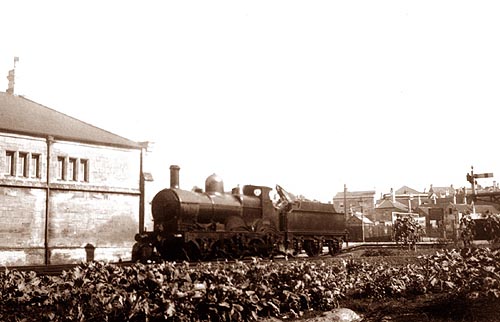 |
|
| In 1926 H.C. Casserley photographed a Churchward No.3223 "Barnum" class passing through the Station and Goods Yard. Today they provide a unique glimpse of a bygone era. In the foreground can be seen cabbages growing on the staff's allotments and in the background is Brunel`s Goods Shed built in 1848 | |
 |
|
Similar
to above |
|
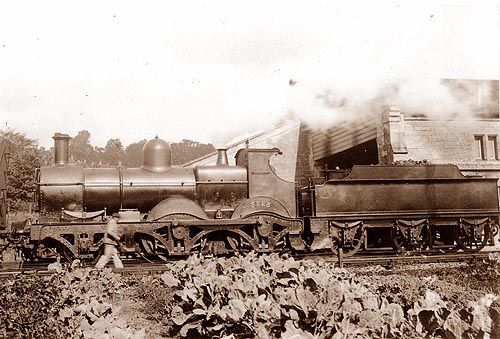 |
|
Similar
to above |
|
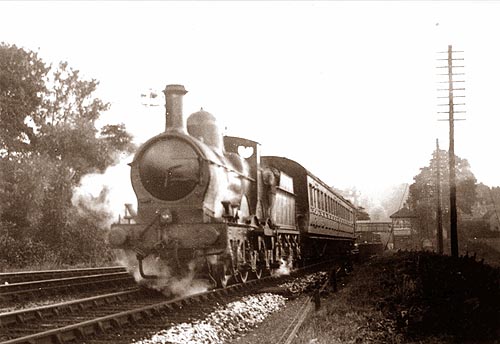 |
|
Similar
to above |
|
1928 |
|
The
Great Western Railways 4900 Class or Hall Class is a class of 4-6-0 mixed
traffic steam locomotives designed by Charles Collett often to be seen
in photographs of Bradford Station in the 1950` and 60`s. |
|
1939-45 |
|
| During
the Second World War in 1943, Thingley Junction was also made triangular
with a West Curve to give more flexibility in moving trains. Both these
additional curves have been removed in modern times. |
|
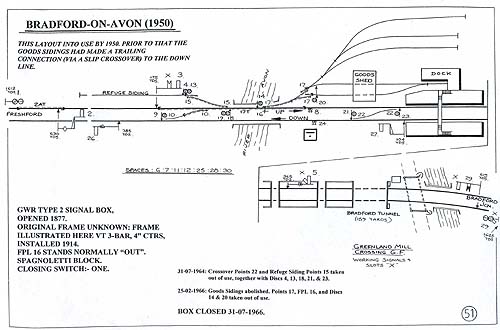 |
|
1948 |
|
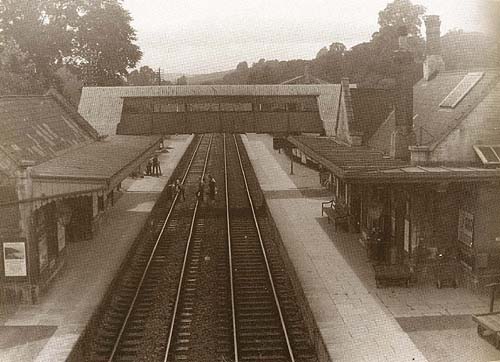 |
|
A
view from Frome Road Bridge of the Station in the 1930`s |
|
| The
British Transport Commission was created by Clement Attlee's post -war Labour
government in 1947 as part of its nationalisation programme to oversee railways,
canal and road freight transport. It came into operation on 1st January
1948. British Railways was divided into five regions: the Scottish Region
was new, but the Midland, Eastern, Southern and Western region corresponded
to the rail companies created in 1923. Many staff on the Western Region
continued to proudly wear their G.W.R. insignia. The Western Region built a large number of steam locomotives to GWR designs, even after the advent of diesel shunters. The BR standard class 3 was also built for the Western Region. The Region experimented with diesel hydraulic traction such as the British Rail Class 52 Westerns and British Rail Class 35 Hymeks based on West German designs; these were all eventually replaced with British Rail national standard diesel electric classes. |
|
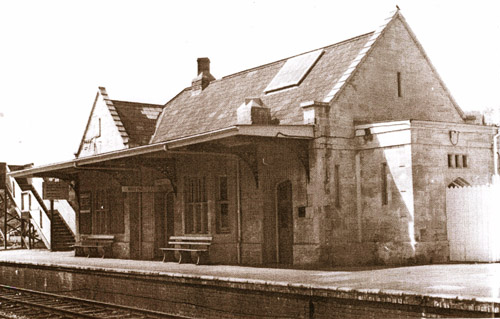 |
|
Bradford
on Avon Station c.1960 . Note the stone Chimneys removed and partly rebuilt
in brick. |
|
 |
|
 |
|
 |
|
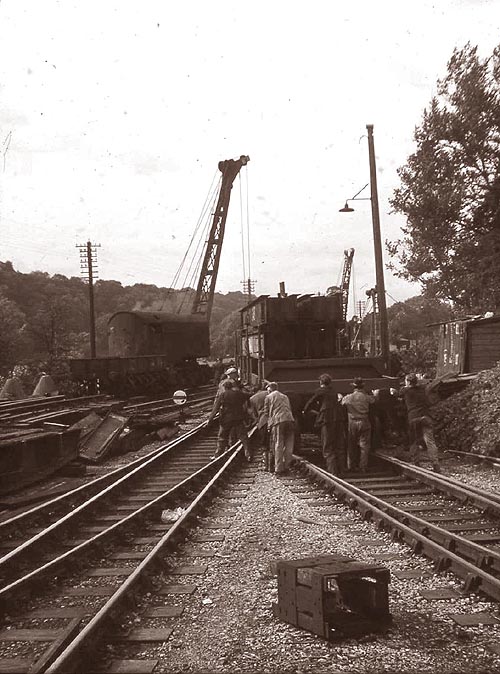 |
|
The
rebuilding of Barton Bridge over the Avon in 1960 |
|
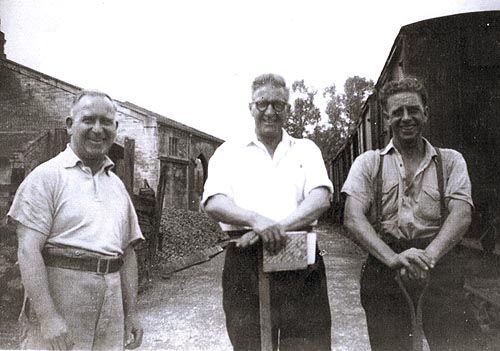 |
|
Workmen
in the Goods Yard with the Old Goods Shed in the background (demolished
1966) |
|
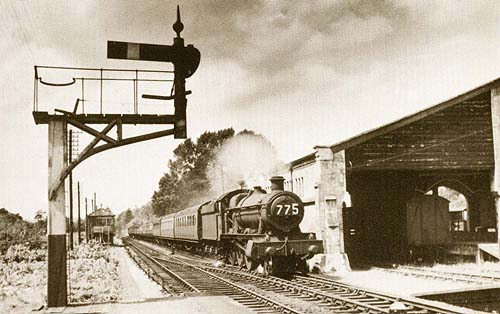 |
|
No.6958
"Oxbury Hall" passing the Goods Shed in 1951 |
|
 |
|
| Engineering work at Bradford on Avon c.1960. The Collett 3MT 0-6-0 Locomotives no. 2269 is at the Up platform whilst the no. 2205 is in the Goods Yard. It is interesting to see the two young train spotters on the platform and the platelayers resting against the Goods Shed wall, shovels and coats on the railings. Sadly this view is gone forever. | |
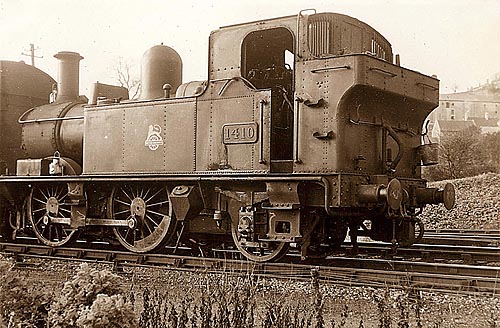 |
|
| no. 1410 at Bradford on Avon with the area known as New Town on the horizon. | |
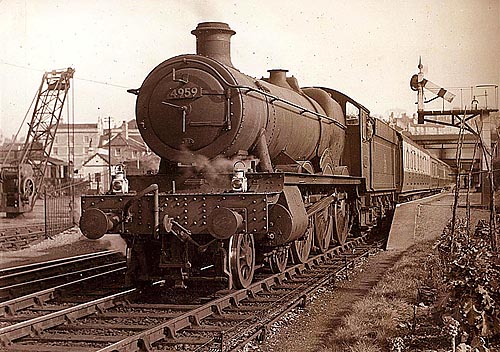 |
|
no.
4959 Purley Hall, built in 1929 at Swindon.The first shed allocation was
at Westbury. Notice the rare glimpse of the Crane in the Goods Yard, now
the Station Car Park. It was withdrawn in December 1964 and scrapped at
Buttigieg's, Newport. |
|
 |
|
| The 9.03 saturdays only from Portsmouth to Cardiff passing behind no. 5998 "Trevor Hall" on 14th July 1951 at Bradford on Avon with the station in the distance | |
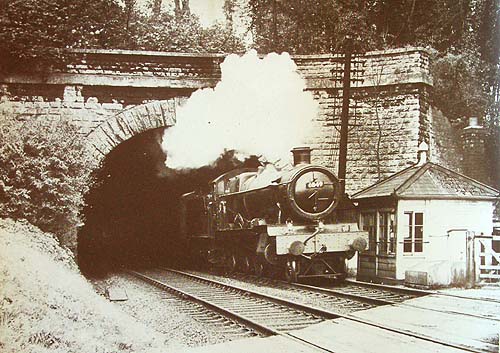 |
|
6849
"Walton Grange" with a Sunday parcel train emerging from the
tunnel by Greenland Mill Bradford
on Avon in 1961. The Greenland Mill signal box disappeared when the Level
crossing was fitted with automatic barriers in November 1966 |
|
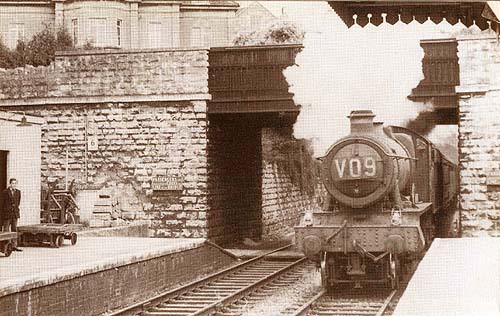 |
|
A
Hall class 4-6-0 passing under Frome Road Bridge in 1962 |
|
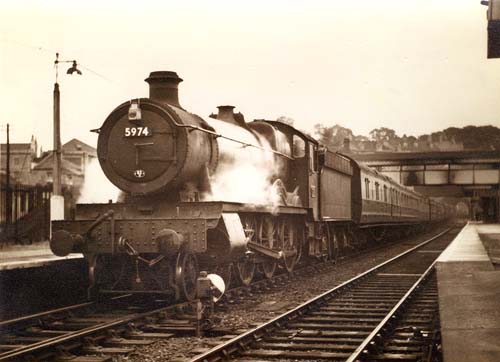 |
|
Wallworth
Hall (4-6-0)at the up platform, with a down train, at Bradford on Avon
on 11th September 1955eptember 1955. |
|
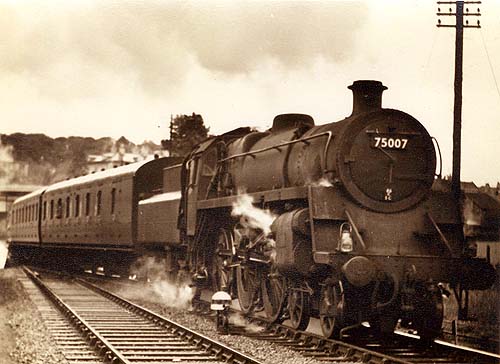 |
|
Standard
Class 4MT 4-6-0 no.75007 (85c) crossing over the up road to the down road,
at Bradford on Avon on the 11th Sptember 1955. |
|
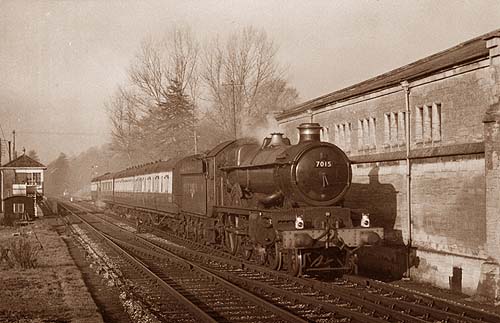 |
|
| Castle Class 4-6-0 no.7015 Carn Brea Castle (82A) possibly on a Portsmouth or Weymouth train. It is passing the Bradford on Avon Goods Shed and in the distance is the signal box. | |
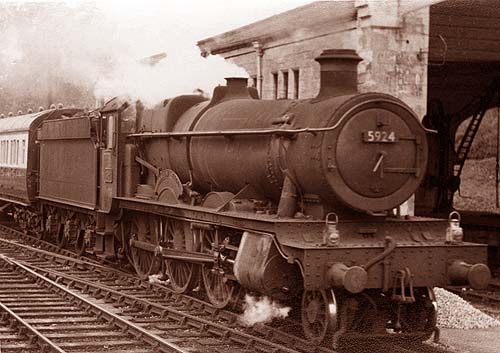 |
|
| The 10.30a.m. Cardiff to Portsmouth Train entering Bradford on Avon hauled by the Hall class 4-6-0 5924 Dinton Hall (82B) on the 22nd October 1955 | |
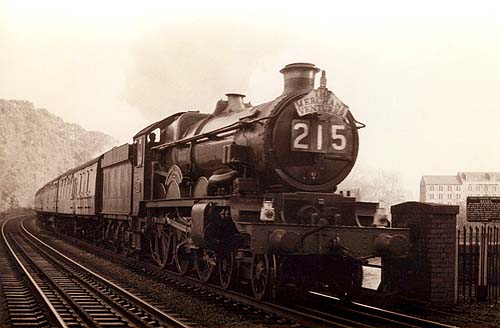 |
|
A
Castle Class 4-6-0 at Greenland Mills crossing. The train is the "Merchant
Venturer" diverted from Chippenham via Melksham, Holt Junction, Bradford
Junction and Bradford on Avon to Bath, then on to Bristol Temple Meads
and Weston Super Mare. |
|
 |
|
A
local train hauled by a 2-6-0 locomtive crossing the River Avon at Bradford
on Avon on Barton Bridge over the River Avon. |
|
 |
|
Castle
Class 4-6-0 No. 7029 Clun Castle train 1X84 an excursion organised by
the Stephenson Society passing Bradford on Avon. Note the Railwayman`s
allotment in the background. |
|
 |
|
5065
Newport Castle. Originally built as Upton Castle, July 1937. withdrawn
January 1963. Scrapped at A. King & Son, Norwich.This photograph taken
on the 9th September 1961 shows it hauling the down "Torbay Express",
not carrying the headboard, at Holt Junction. The fireman is putting the
single line token for the Devizes branch on the hook. |
|
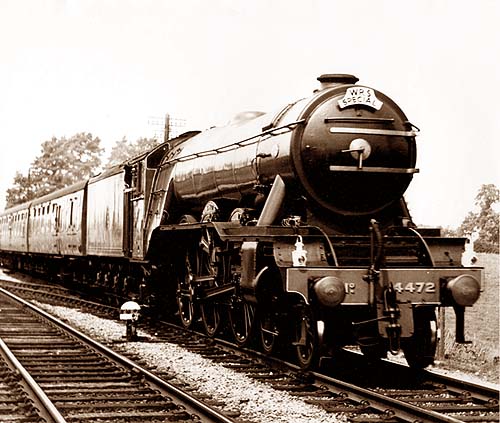 |
|
No.4472
Flying Scotsman at Bradford Junction hauling a Warwickshire Railway Society
Special. |
|
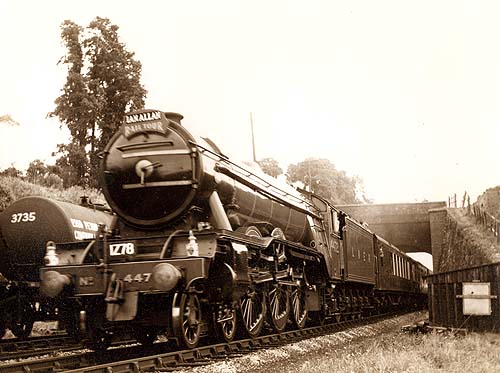 |
|
No.4472
Flying Scotsman passing under the Aqueduct carrying the Kennet and Avon
Canal, at Avoncliff hauling 1278 an Ian Allen Rail Tour which came via
Devizes, Bradford Junction and Bradford on Avon. |
|
 |
|
| GWR no. 7011 Banbury Castle. Built June 1948. First shed allocation Bristol, Bath Road. Withdrawn February 1965. it is shown leaving Bradford on Avon with a Portsmouth to Cardiff train | |
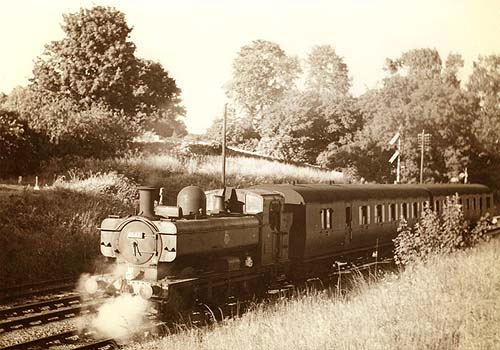 |
|
no.
4647. built 1943 at Swindon and was withdrawn in 1962. The '5700' (0-6-0)class
of light goods and shunting engines were the largest of any one class
produced for the GWR totalling 863 engines. It is shown here between Bradford
on Avon and Avoncliff. |
|
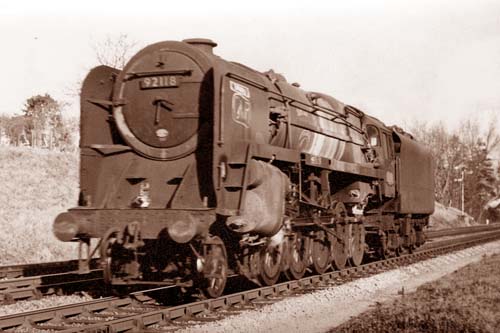 |
|
A
2-10-0 9F freight Locomotive no. 92118 running light through Bradford
on Avon towards Bath. |
|
 |
|
A
Castle Class 4-6-0 at Greenland Mills crossing. The train is the "Merchant
Venturer" diverted from Chippenham via Melksham, Holt Junction, Bradford
Junction and Bradford on Avon to Bath, then on to Bristol Temple Meads
and Weston Super Mare. |
|
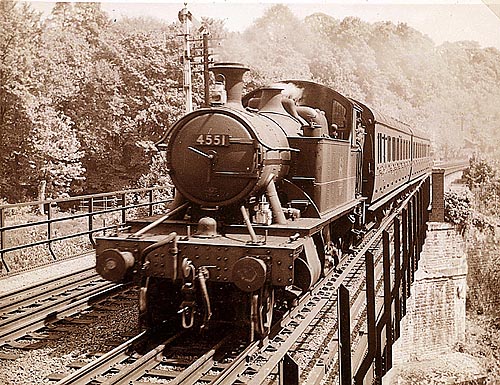 |
|
| The no. 4551 Tank engine was built in 1915 and withdrawn in 1958 . It is shown here at Greenland Mill Crossing near Bradford on Avon Station | |
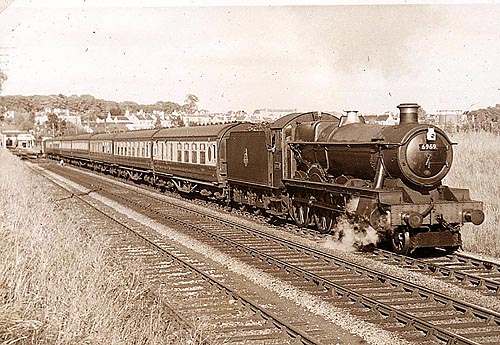 |
|
4968
Shotton Hall was built at Swindon in 1929. The last shed allocation was
Bristol, St. Philip's Marsh and was withdrawn in July 1962 and scrapped
at Cashmore's, Newport. It is shown here leaving Bradford on Avon Station
en route to Bath. |
|
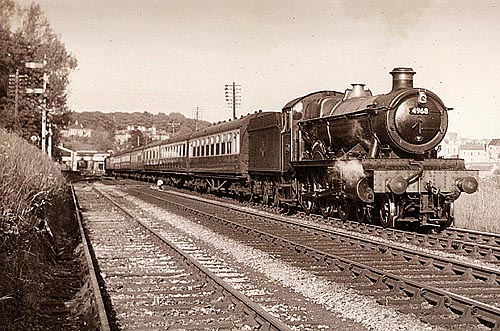 |
|
| 4968 Shotton Hall was built at Swindon in 1929. The last shed allocation was Bristol, St. Philip's Marsh and was withdrawn in July 1962 and scrapped at Cashmore's, Newport. It is shown here leaving Bradford on Avon Station en route to Bath. | |
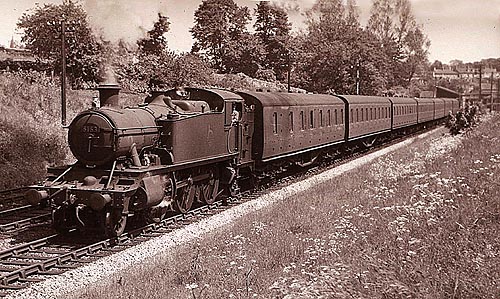 |
|
The
no. 6168(2-6-2) was built in 1935 and withdrawn in 1962 . It is shown
here leaving Bradford on Avon Station. |
|
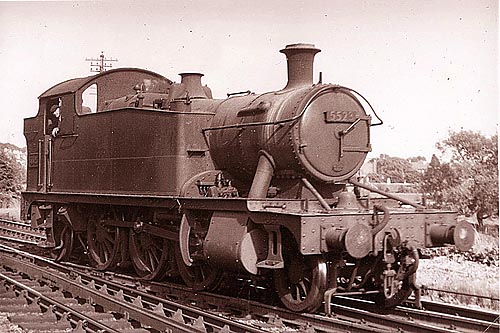 |
|
GWR Tank Engine no. 5523 at Barton Farm, Bradford on Avon |
|
 |
|
4968
Shotton Hall was built at Swindon in 1929. The last shed allocation was
Bristol, St. Philip's Marsh and was withdrawn in July 1962 and scrapped
at Cashmore's, Newport. It is shown here leaving Bradford on Avon Station
en route to Bath. |
|
 |
|
Collett
Class 2251 3MT 0-6-0 2268 (82D - Westbury) crossing
over from the down line to the upline so the container wagon could be
deposited in the goods yard( note the sidings signals). |
|
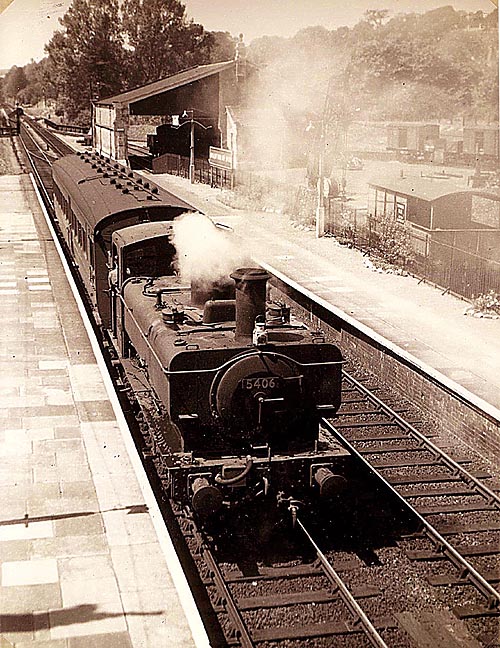 |
|
A
GWR Pannier Tank 5406 in Down Platform on 1 Coach Auto Train. The Goods
Shed and Yard can be clearly seen in the background. |
|
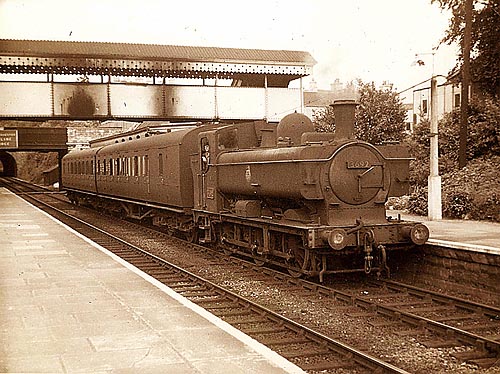 |
|
GWR Pannier Engine no. 3692 on down line, 2 coach train at Bradford on Avon. |
|
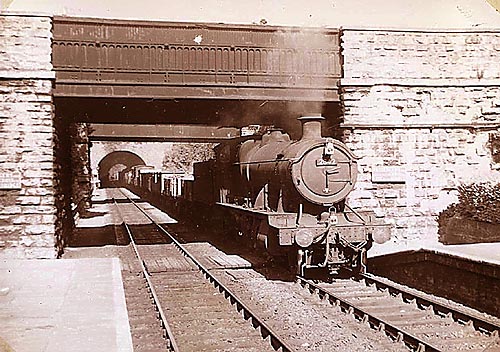 |
|
| GWR no. 2842(2-8-0) , built between 1911-1913 on down line hauling freight under Frome Road Bridge at Bradford on Avon. | |
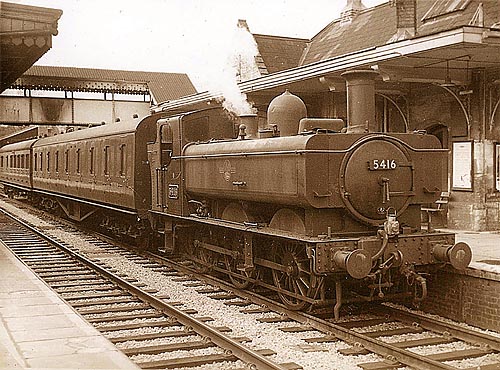 |
|
The
GWR Pannier Tank Engine in Bradford on Avon station built
in 1932, Most of the '5400' class had been withdrawn by 1960 due to the
introduction of the diesel railcar. It was to be immortalised by the Rev.
Awdry as "Duck" in the tales of Thomas the Tank engine |
|
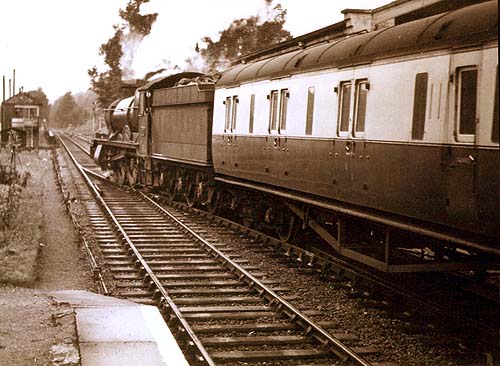 |
|
Wallworth
Hall (4-6-0) crossing from the up road to the down road at Bradford on
Avon on 11th September 1955. |
|
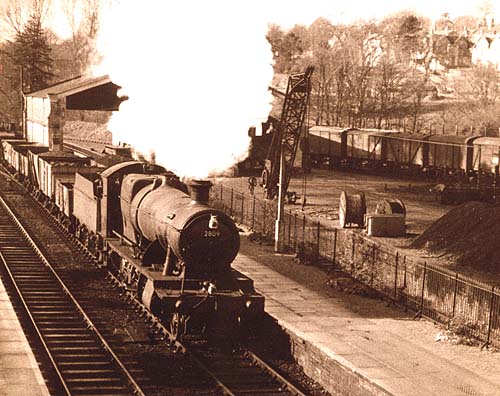 |
|
No.
2908 ( class 2-8-0) was built in 1905 and was withdrawn in 1960. It is
shown here at Bradford on Avon by the Goods Yard, now the Station Car
park |
|
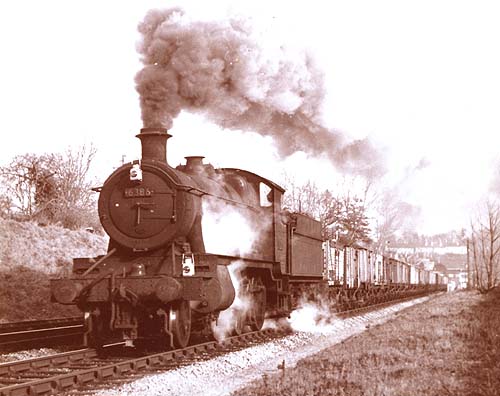 |
|
Churchward
design 2-600 4300 Class 4MT No.6386 passing Bradford on Avon with a down
freight. This locomotive is leaking plenty of steam from various places
but is still doing a grand job, going well.. |
|
1961 |
|
| The first regular diesel locomotive workings occurred on 16th September, with a "Hymek" diesel hydraulic. | |
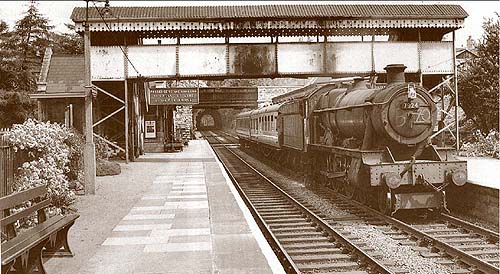 |
|
No
7024 "Thornycroft Hall" arriving in Bradford with a Salisbury
Train in 1963 |
|
1963 |
|
| By 1963 main-line diesel locomotives were arriving in large numbers. | |
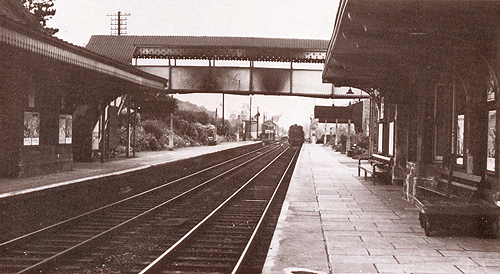 |
|
Bradford
on Avon Station c.1960 |
|
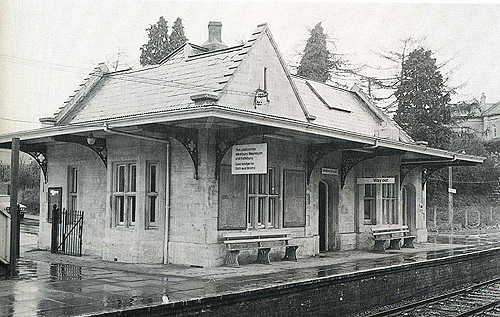 |
|
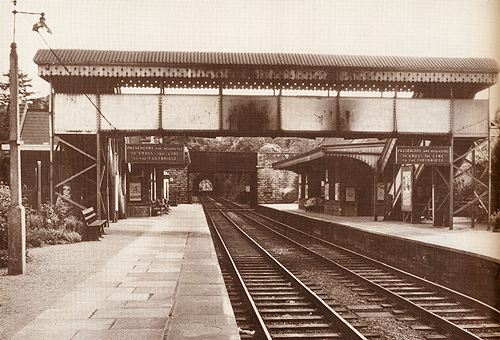 |
|
Bradford
on Avon Station in 1963 |
|
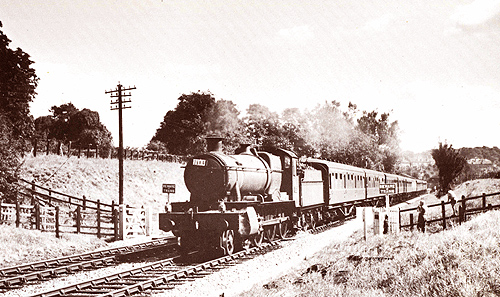 |
|
No.
7829 Ramsbury Manor leaving Bradford on Avon in 1964 |
|
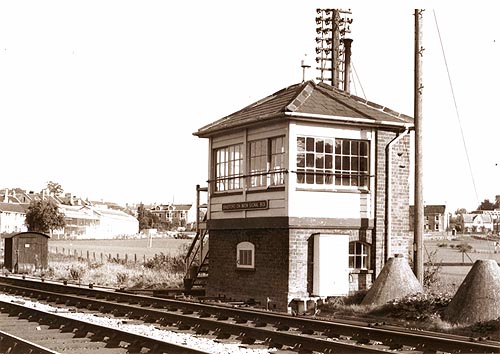 |
|
 |
|
The
Signal Box near Barton Bridge, demolished 1966 with the second world War
Tank emplacements alongside which are still to be seen. |
|
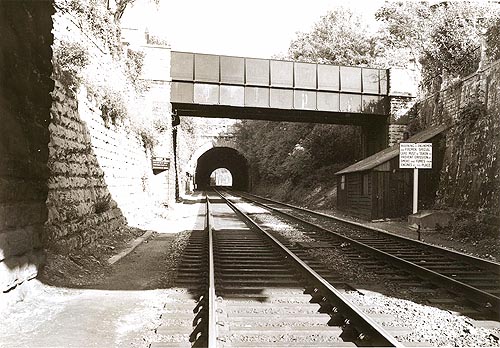 |
|
Trowbridge
Road Bridge in 1962 with tunnel in distance and workmans cabin on the
right. |
|
 |
|
Station
in 1962 with Frome Road Bridge and tunnel in distance |
|
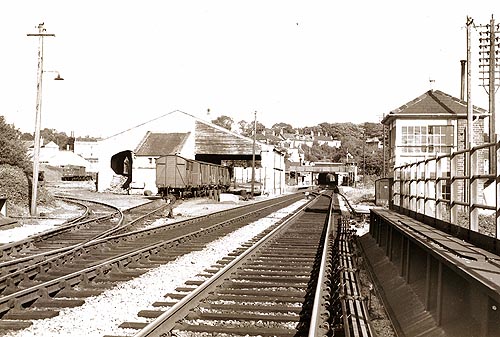 |
|
The
Goods Shed and Yard with the Signal Box on the right in 1962 |
|
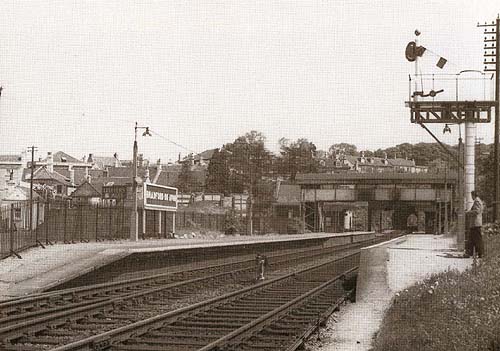 |
|
| An early view of the station showing the Goods yard which was to go in1964 and the signals | |
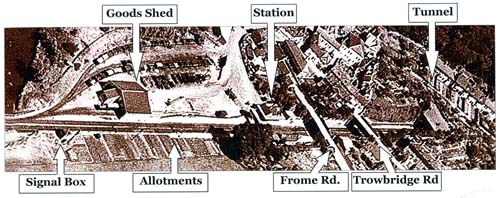 |
|
| An aerial view c.1960 showing the Goods Shed with its yard, the signal box anfd staff allotments alongside the station. | |
1964 |
|
| 2nd November the goods yard was closed to traffic but remained in use for coal for a further year. The goods shed lines were reduced to one track, and the two sidings at the rear (and nearest to) the shed became redundant. | |
1966 |
|
| After
the withdrawal of goods traffic the other shed road became disused in February
1966. In July the up refuge siding and both the main line trailing crossovers
were removed. At the same time the signal box was closed, signals now being
controlled elsewhere. This was the year that Limpley Stoke Station was closed
on 3rd October. Dr. Beeching, chairman of I.C.I. who had been appointed by the government to investigate and recommend a plan for the future of the railways, presented his report. It proposed the closing of many branch lines, leaving large parts of the country without a connection to the railway. It had been evident for years that the growth of motor transport was taking traffic from the railways, just as they had done from the canals, but the severity of the cuts came as a shock. Maps accompanying the Beeching Report showed that passenger traffic on the Bathampton - Bradford-Trowbridge-Westbury line was about 50,000 passengers per week and that Bradford on Avon's ticket sales were between £5,000 and £25,000 a year. Freight traffic was given as about 50,000 tons per week, with less than 5,000 tons a year being loaded or unloaded at Bradford on Avon. Beeching recommended that the line should remain open, but that passenger services be modified. |
|
1967 |
|
| Station
Master's House demolished. It stood at the corner of Frome Road and Station
Yard, where the Fish and Chip Restaurant is now. The late 1950`s saw first
a reduction, then the final withdrawal of Britain's fleet of steam locomotives
with the last steam locomotive working in Bradford until 1967. The Western
region was the first to have no steam Locomotives. |
|
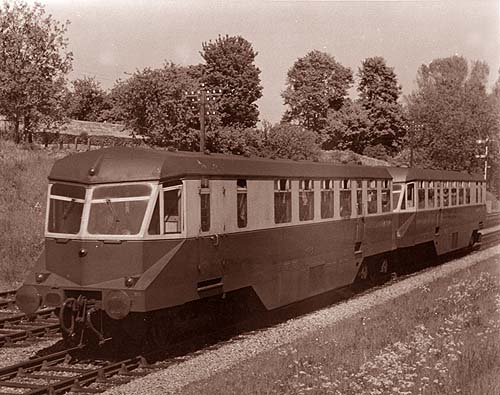 |
|
| In
1933, the Great Western Railway introduced this Diesel railcar. Here it
is seen at Bradford on Avon. This a most unusual coupling of two vehicles
normally they were coupled back to back, so the driving cabs were facing
outwards. These two were coupled tail to nose. These sets sometimes had a coach sandwiched between them and were used between Bristol Temple Meads to Weymouth and return. this was the afternoon return service from Weymouth. |
|
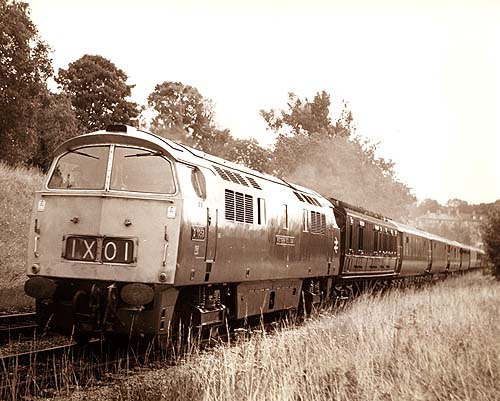 |
|
The
Royal train conveying HM the Queen and Prince Philip from Staverton (
where they spent the night) to Bath, at Bradford on Avon on 9th August,
1973. The Locomotive is no. 1058, Western Nobleman. |
|
 |
|
Peak
Class 4 ICO - COI no. D87? train 3004 parcels Train alongside the Goods
Shed (demolished 1965). |
|
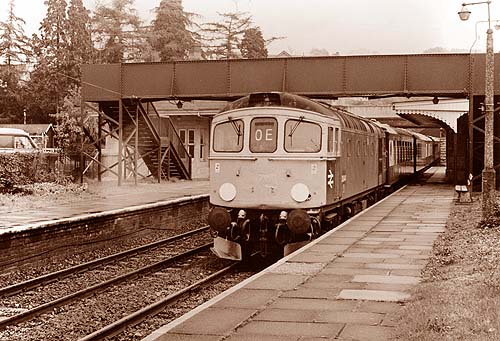 |
|
The
"Orient Express" (VSOE) Victoria to Bristol at Bradford on Avon
Station. |
|
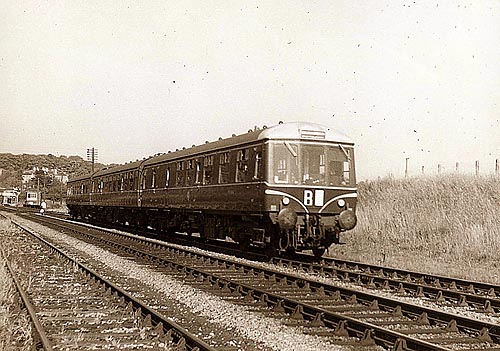 |
|
British
Rail Cross Country Diesel, Multiple Unit down at Barton Farm,Bradford
on Avon c.1966. |
|
 |
|
British
Rail Hymek Diesel c.1965 entering Bradford on Avon Station with the Goods
Shed covered with snow in the background. The Signal Box opposite can
still be seen before its demolition in 1966. |
|
 |
|
Hymek
Diesel Hydraulic locomotive(D7008), built between 1961 -4, up afternoon
train was seen at Bradford on Avon on 16th April 1964. |
|
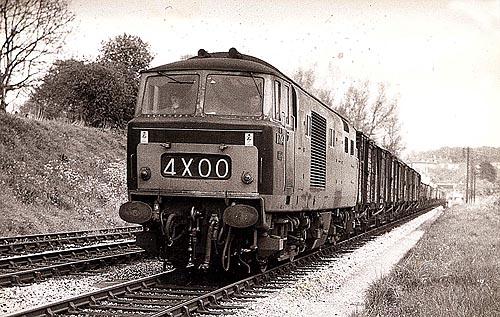 |
|
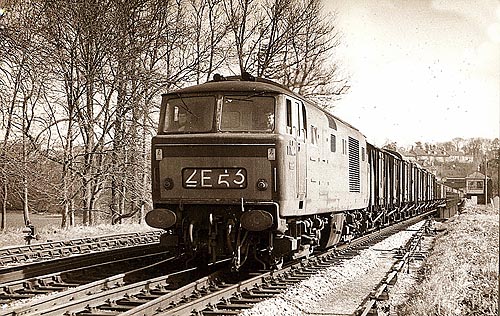 |
|
Hymek
Diesel on 2E53 down freight passing Barton Farm with the signal box in
the distance. |
|
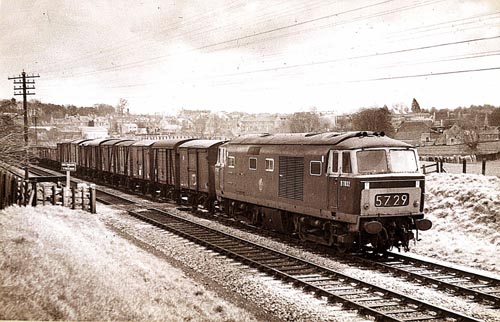 |
|
Hymek
Diesel Locomotive(5729) with freight passing Barton Farm in Bradford on
Avon. |
|
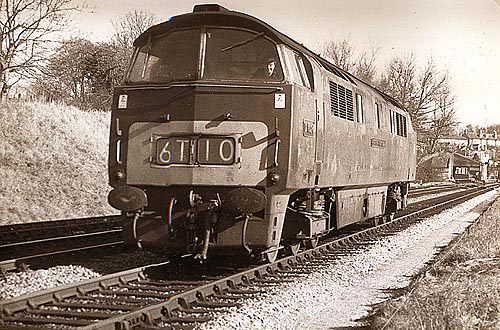 |
|
"Western"Diesel
D1024 GT10 light engine passing Barton Farm with Bradford on Avon Station
in the background. |
|
 |
|
D1909
down Brush Type 4 Diesel(Z61) with mixed freight going under Frome Road
Bridge as it enters Bradford on Avon Station the 16th April1966. |
|
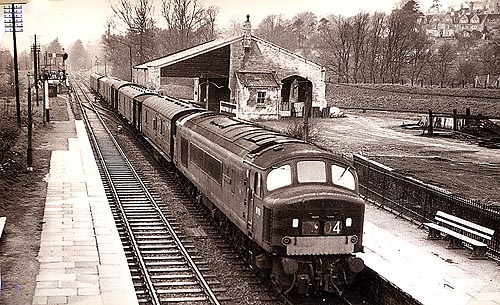 |
|
The
up afternoon Parcels train in Bradford on Avon Station with the Goods
Shed in the distance c. 1964. |
|
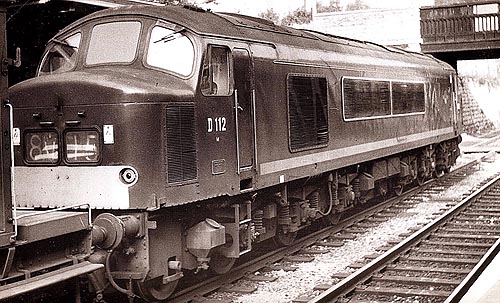 |
|
The
British Railway Sulzer Type4 Peak D20 (8V15) at Bradford on Avon Station
in 1967. |
|
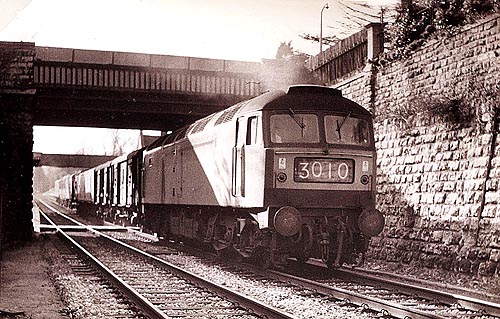 |
|
Parcels
Train leaving Bradford on Avon for Trowbridge going under the Trowbridge
Road Railway Bridge. |
|
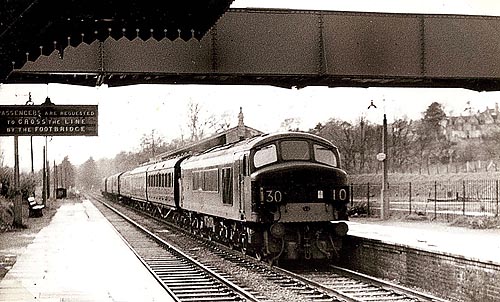 |
|
British
Railways 3010 Class 44 or Sulzer type 4 "Peak" were built between
1959- 1960 at Derby. It is shown on parcels at Bradford on Avon Station
c.1967 . |
|
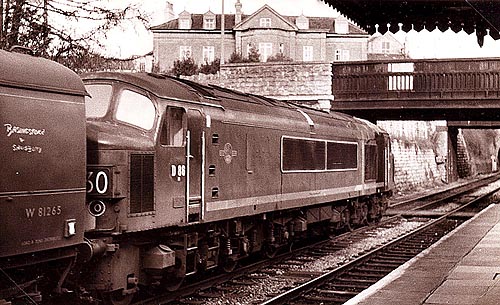 |
|
The
British Railway Sulzer Type4 Peak D86 (45105) at Bradford on Avon Station
in 1967. This Locomotive survives at Barrow Hill, Derbys) |
|
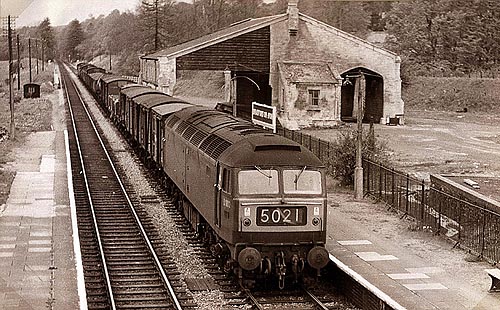 |
|
British
Rail Brush Type4 Sulzer Diesel(D1812) in 1967 entering Bradford on Avon
Station with the Goods Shed in the background. The Signal Box opposite
had been demolished by then. |
|
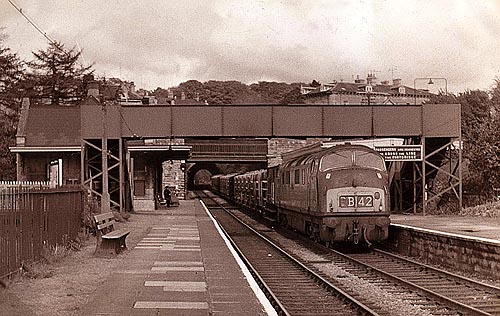 |
|
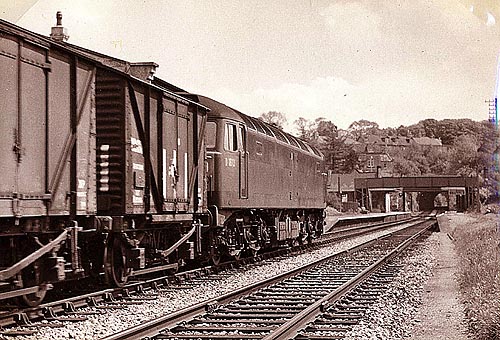 |
|
The
Sulzer-engined, Brush Type 4 locomotive (D1613 (47033) pulling freight
in 1967 by Barton Far. This locomotive still survives at Gloucester. |
|
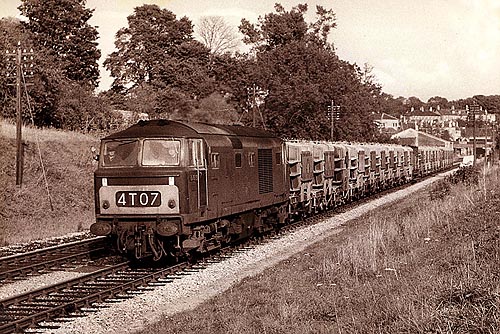 |
|
| Hymek Diesel Hydraulic locomotive(4T07), built between 1961 -4, on down freight. This Cement train was seen at Bradford on Avon c.1964. | |
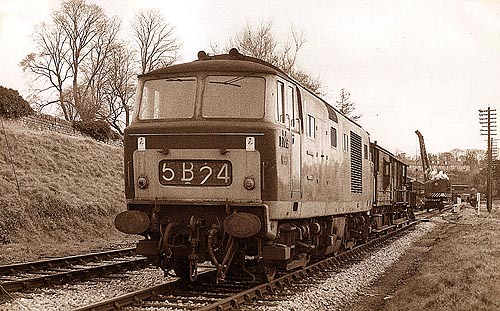 |
|
 |
|
| The Sulzer-engined, Brush Type 4 locomotive (D1613 (47033) pulling freight in 1967 by Barton Far. This locomotive still survives at Gloucester. | |
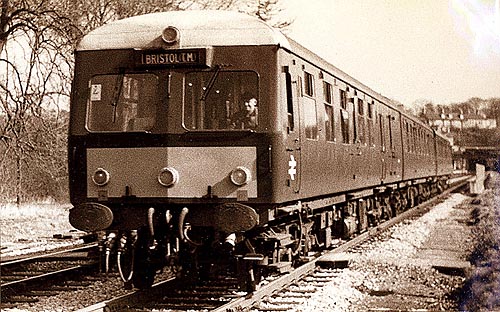 |
|
| British Rail 3 car D.M.V. W50650, 59256, 50708 passing Barton Farm on 22nd September 1967. | |
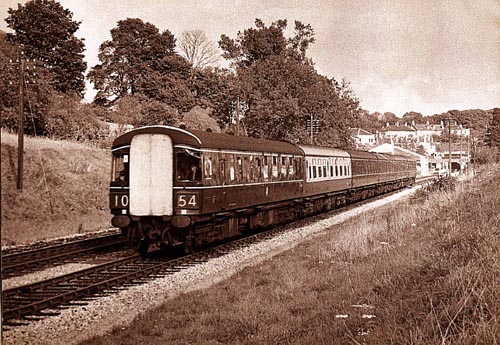 |
|
| British Rail Intercity DMV passing Barton Farm in Bradford on Avon Station on its way to Cardiff on the 22 nd September 1967. | |
 |
|
British
Rail 3 car D.M.V. W50650, 59256, 50708 passing Barton Farm on the 22nd
September 1967. |
|
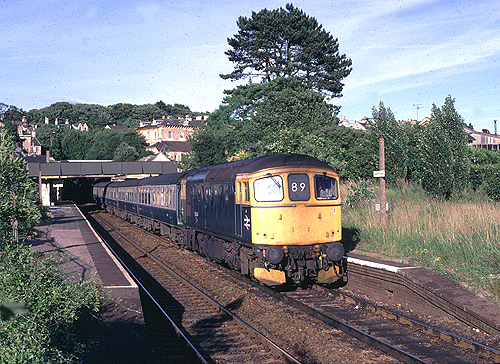 |
|
| A class 33 Diesel hauling a Portsmouth to Cardiff train at Bradford on Avon. | |
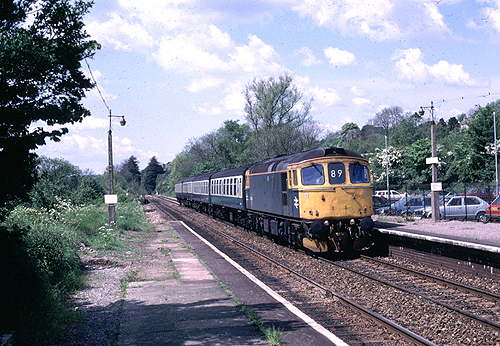 |
|
| A class 33 Diesel hauling a Cardiff to Portsmouth train at Bradford on Avon. | |
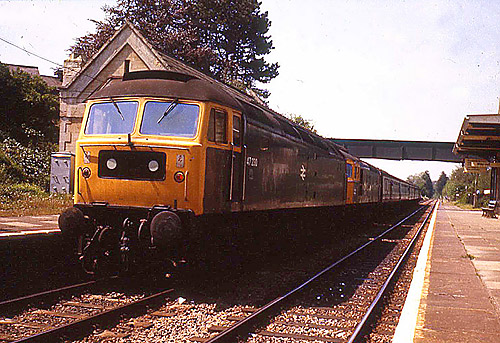 |
|
A
Class 47 British Rail Locomotive passing through Bradford on Avon Station |
|
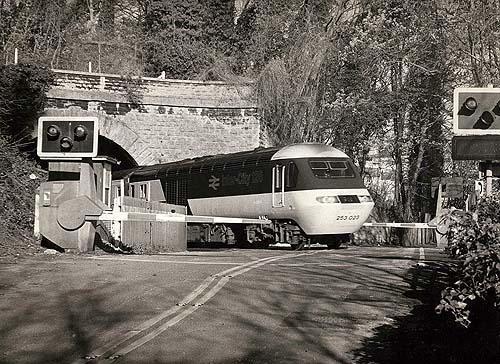 |
|
An
HST Locomotive by the Greenland Mill level crossing. |
|
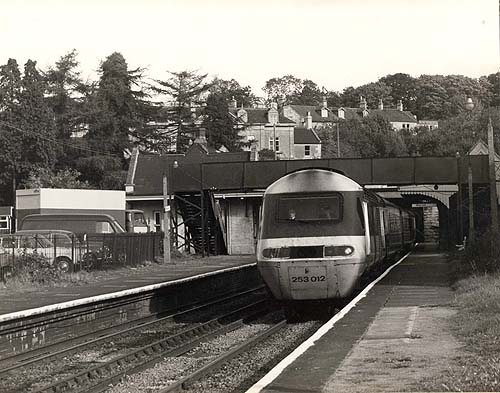 |
|
An
HST Locomotive entering Bradford on Avon Station. |
|
1974 |
|
| Health
Centre built in Goods Yard in 1974/5, the remaining area being turned into
a public car park ( decried at the time as being vastly bigger than the
town would ever need). |
|
1976 |
|
| One of the major triumphs of the Western Region was introduction on the Great Western main line of the Intercity 125 trains, bringing major accelerations to the timetables. | |
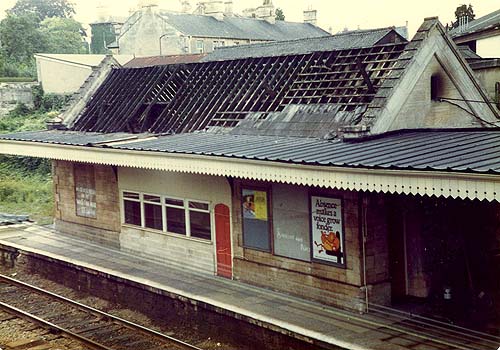 |
|
Damaged
roof after an accidental fire during work on the Shelter on August 9th
1980 |
|
1984 |
|
| In
April of this year plans were announced to single the line between Bathampton
Junction and Bradford Junction, to be undertaken in early 1986, in connection with saving renewal of much of the worn out jointed track on the route. Following a public outcry and a rethink by British Railway, the plan was dropped in late 1984. |
|
1988 |
|
| In
May of this year Sprinters displaced day to day Locomotive hauled Passenger
Trains on Portsmouth - Cardiff route through Bradford on Avon. |
|
1990 |
|
| On
privatisation of the railways in the early 1990s, the "Great Western"
name was revived for the train operating company providing passenger services
to the west. Services are now run by the franchise name First Great Western. |
|
1991 |
|
| In
March Class 158`s-"Express Sprinter" arrive in limited numbers. |
|
1992 |
|
| In August, 1992, the double tracks on a normal weekday carried 38 trains which stop at Bradford and 27 which rush through as expresses. | |
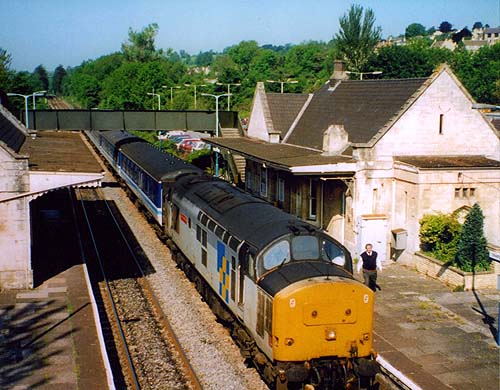 |
|
Class
37 no. 37425 Bristol-Weymouth in 1993 with Ron Adams on the platform |
|
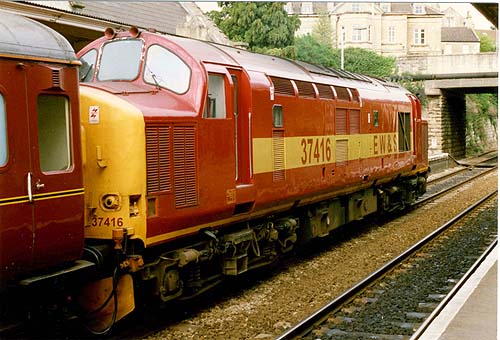 |
|
Class
37 no. 371416 at Bradford on Avon with the nsundays only morning train
to Weymouth. |
|
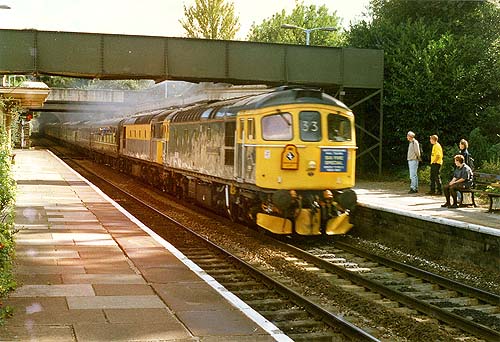 |
|
| 2X class 33 Locomoitves on a charter Train at Bradford om Avon no. 6569 Shakespeare Cliff AN 33030 | |
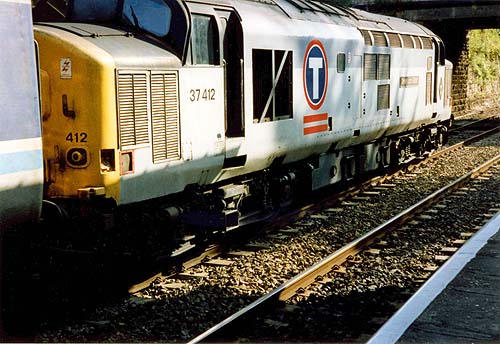 |
|
Class
37 no.37412 driver John Elliott with the sundays only, morning train to
Weymouth |
|
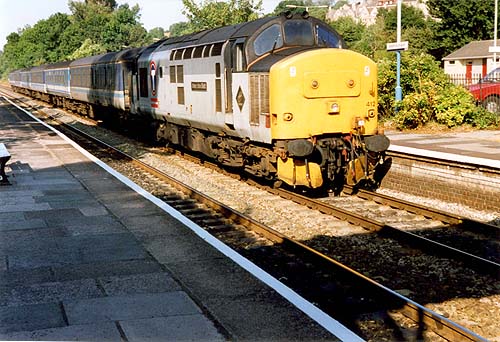 |
|
| Class 37 no.37412 driver John Elliott with the sundays only, morning train to Weymouth | |
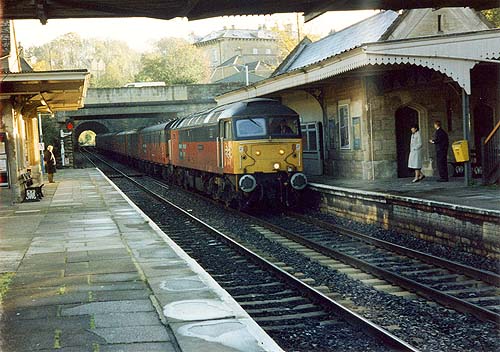 |
|
A
diverted parcels train at Bradford on Avon Station. |
|
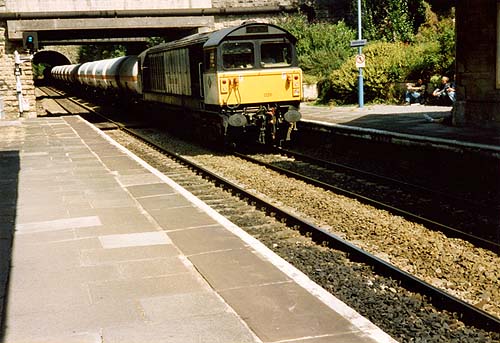 |
|
| A Class 58 no. 58026 Locomtive on a tank train entering under the Frome Road bridge into Bradford on Avon Station | |
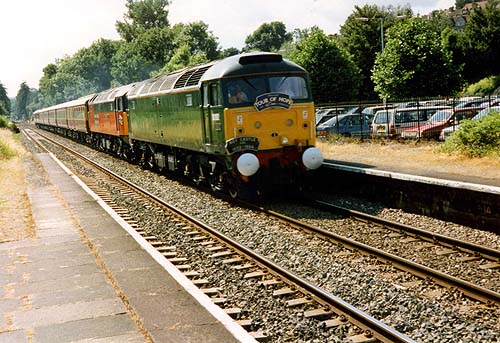 |
|
"Roy
Castle Tour of Hope"double headed by 2x class 47 locomotives. This
train travelled round the country. The second locomotive was called "Roy
Castle". Roy Castle suffered from Cancer , from which he later died. |
|
1994 |
|
| With
the opening of the Channel Tunnel a direct train service from South Wales
via Bristol, Bath, Bradford on Avon, Warminster and Basingstoke to Waterloo
was inaugurated. The conductor's announcements were given in English and
French (usually with a good Welsh accent). |
|
1998 |
|
Railings between Station Forecourt and Goods Yard removed. Station refurbished by Rail Track. |
|
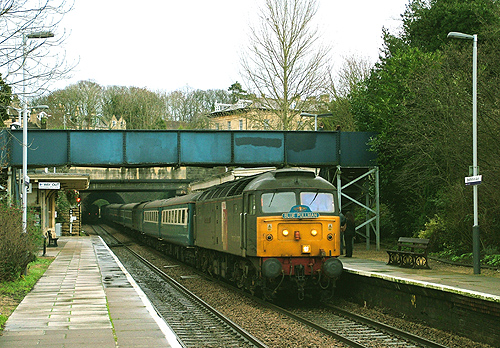 |
|
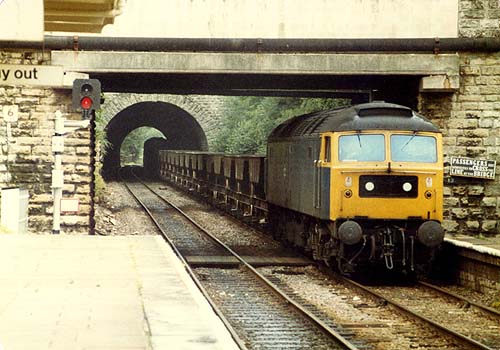 |
|
A
Class 47 Locomotive hauling an Engineers train at Bradford on Avon |
|
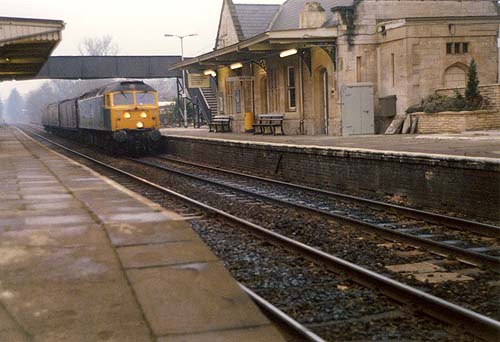 |
|
| A British Rail class 47 locomotive entering Bradford on Avon station | |
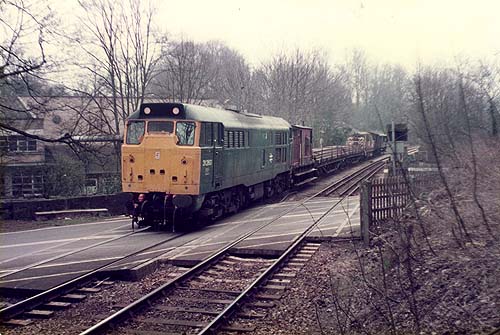 |
|
Class
31 no. 31260 running "wrong road" at Greenland Mills crossing
with an engineers train. |
|
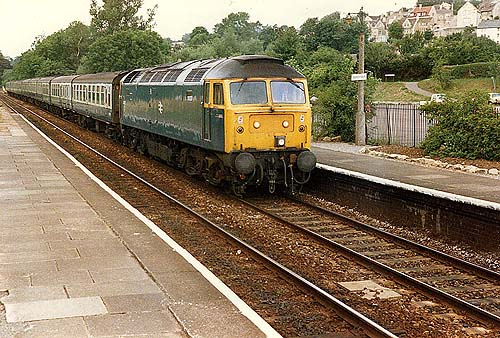 |
|
| A British Rail Class 47 diesel locomitive, also known as Brush Type Four entering Bradford on Avon Station. | |
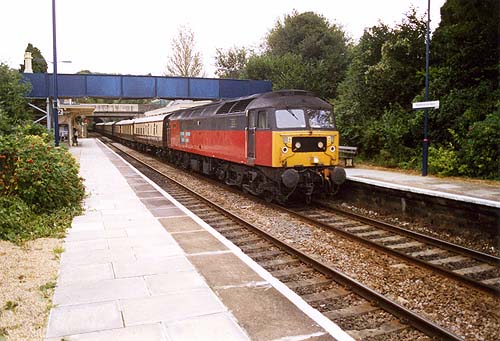 |
|
| A Class 47 Locomotive heading the down Orient express Car Train | |
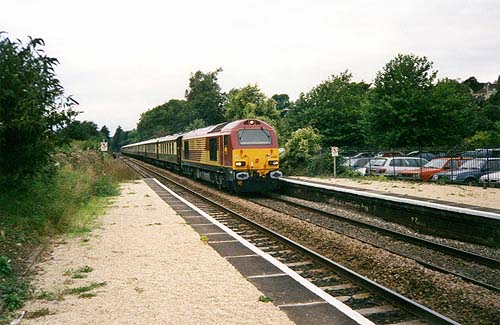 |
|
| A Class 67 Locomitive hauling the up Orient Express Pullman Car Train | |
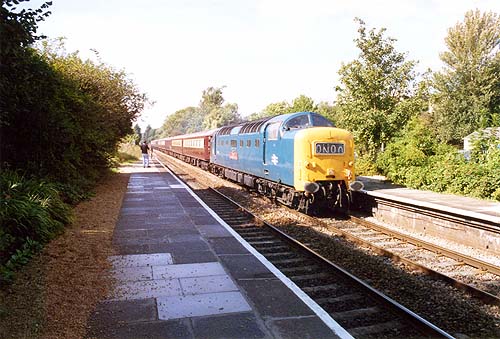 |
|
A
class 55 "Deltic" Co-Co hauling a Charter train |
|
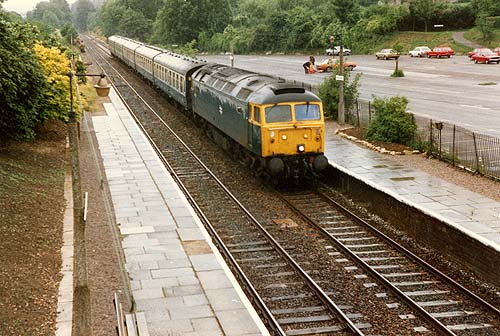 |
|
A
British Rail class 47 Locomotive entering Bradford on Avon Station |
|
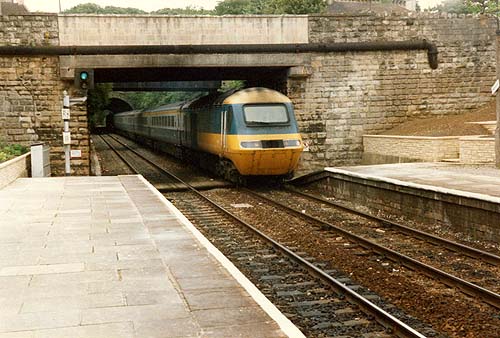 |
|
An
HST Locomotive entering Bradford on Avon Station. Note the signal BJ102
operated from Bradford Junction Signal Box. |
|
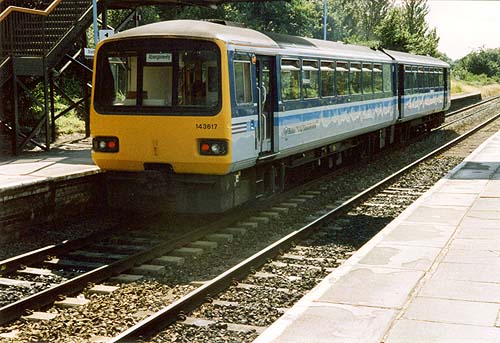 |
|
| A two-coach Class 143 Pacer no. 143610 railbus entering Bradford on Avon station | |
 |
|
A
Class 150 entering Bradford on Avon Station. |
|
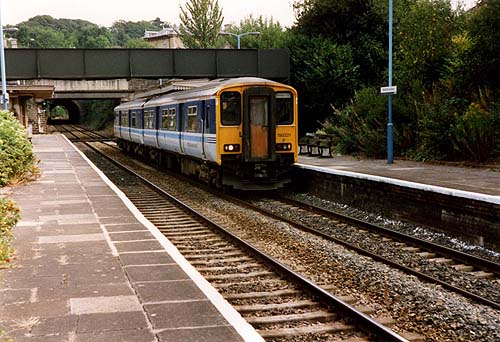 |
|
A
class 150 no. 150221 at Bradford on Avon Station heading for Bristol Temple
Meads
|
|
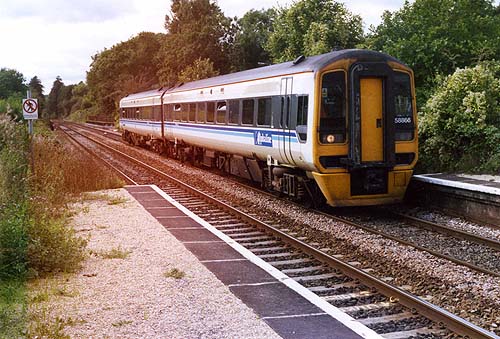 |
|
| A Class 158 No. 158866 Alphaline Service Train at Bradford on Avon | |
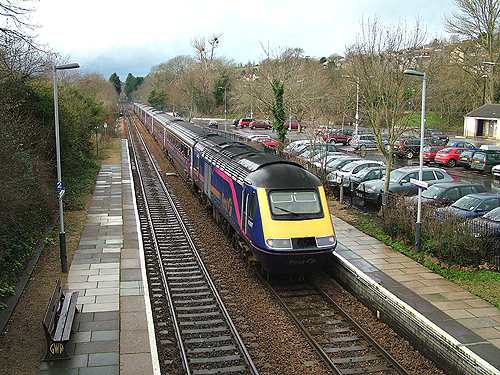 |
|
| A High Speed Train entering the Station. To the right is the Car Park formerly the site of the Goods Yard | |
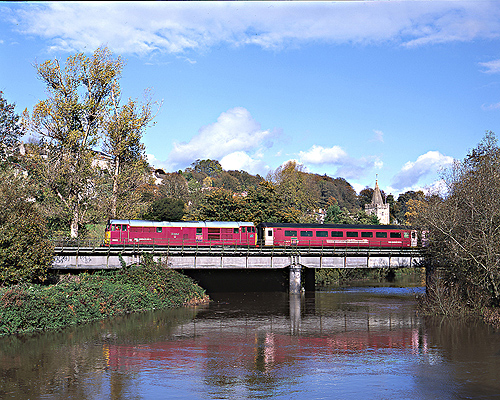 |
|
| 31601 in the infamous Pink livery of the short lived Wessex Train era. 11.00 Weymouth - Bristol T.M. on 25th October 2004 crossing the River at Bradford on Avon. | |
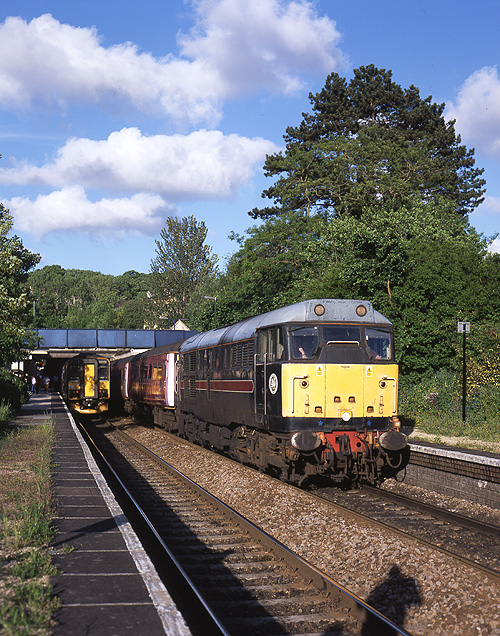 |
|
| The class 31`s were built between 1957-62. Their use by Wessex trains lasted for 2 years from 2005. This is 31459 at Bradford on 28th May 2005 with the 17-016 Weymouth to Bristol Wessex Train Service. The Locomotive wears the black livery of its owner , Hire Company "Fragonset Railways" | |
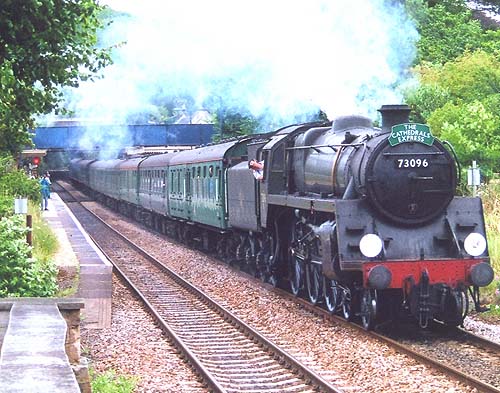 |
|
| British Railways Standard Class 4-6-0 no. 73096 hauling the "Cathedrals Express" to Bristol Temple Meads passing Bradford on Avon | |
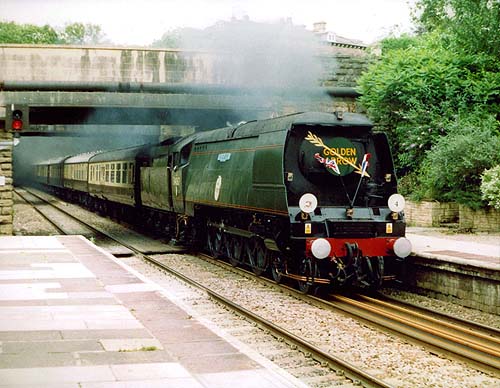 |
|
| Battle of Britain class 4-6-2 no. 34067 TANGMERE hauling the Orient Express Victoria to Bristol Temple Meads. Note the " Golden Arrow" headboard and the English and French flags | |
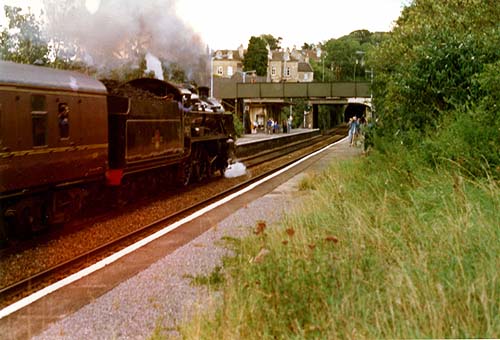 |
|
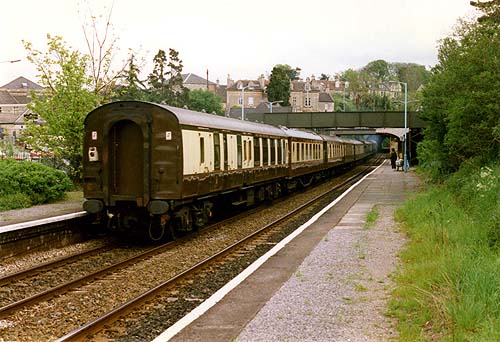 |
|
the
return Orient Express passing Bradford on Avon |
|
 |
|
An
unusual view looking down the platform from the footbridge in 2004. The
train approaching is the South West Trains Bristol Temple Meads to Waterloo.
And the one nearest going on to Bristol temple Meads |
|
2006 |
|
On 1 April First Great Western, First Great Western Link and Wessex Trains combined into the new Greater Western Franchise. First were announced as the operator of the combined franchise in December 2005 for a 10-year period |
|
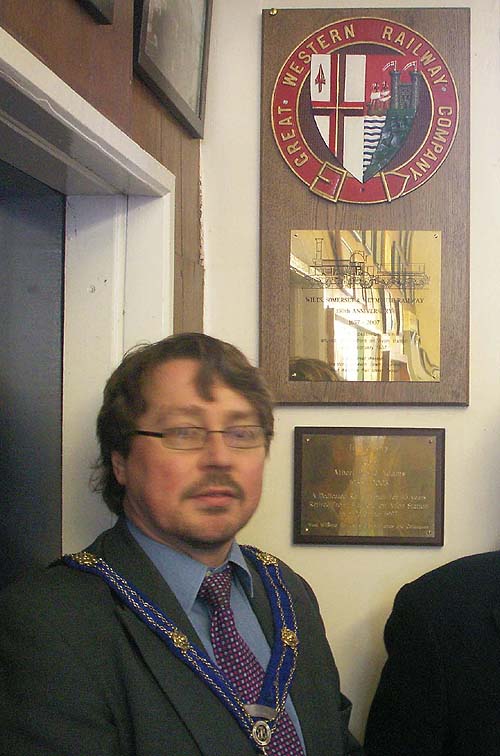 |
|
2007 |
|
| The
150th Anniversary of Bradford on Avon railway was celebrated at the Station.
The Town Mayor, Cllr Peter Leach, unveiled a plaque at 11 am on Friday February
2nd, 150 years to the day after the station was opened. On Saturday July
21st there was further celebration when a Pannier Tank Engine loaned from
Severn Valley Railway was placed on the forecourt of the Station. This class
of locomotive had been a regular visitor to the Station in the past |
|
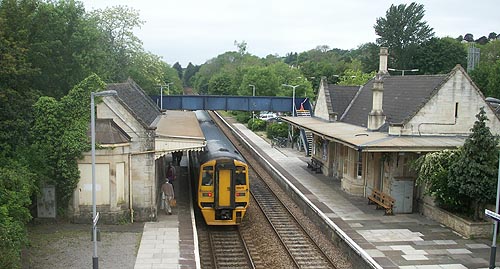 |
|
| The Station in 2007 showing the buildings almost as they appeared to Brunel when finished in 1848. Up until 1966 his fine Goods Shed would have completed the picture but sadly it was demolished in that year. The roof over the footbridge went in 1964 | |
